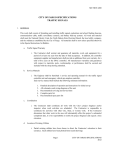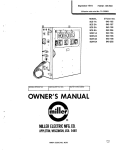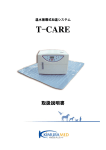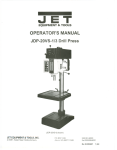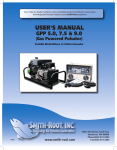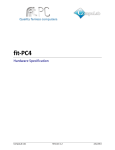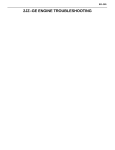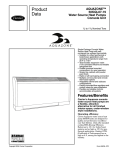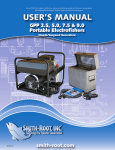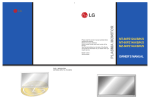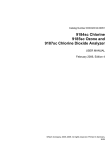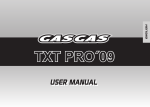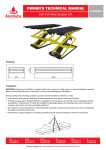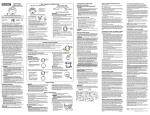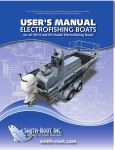Download USER`S MANUAL - Smith-Root
Transcript
Since 1964, the leader in effective, safe and reliable products for fisheries conservation. Knowledgeable biologists depend upon Smith-Root equipment. USER’S MANUAL GPP 2.5, 5.0, 7.5 & 9.0 Portable Electrofishers (W/Kohler/Honda/Generators) ® SMITH-ROOT Products for Fisheries Conservation WWW.SMITH-ROOT.COM 07290.11 USER’S MANUAL CONTENTS INTRODUCTION...............................................................3 APPENDIX: Advanced Troubleshooting Unpacking.......................................................................... 4 Check Generator 12 AC Voltages (all models)... 28 Choosing a Location...................................................... 4 Test for Continuity, High Voltage AC Output..... 29 Fuel Shut-Off Valve.........................................................5 Check connections, brushes, exciter rectifier....30 Power Supply Controls..................................................5 Check Rotor Windings................................................. 31 Operating Procedure......................................................8 Check Stator Windings............................................... 32 Maintenance...................................................................... 9 Test GPP Control Box.................................................. 33 Electrofisher Controls.................................................... 6 Test GPP Control Box..................................................34 Gpp Display........................................................................7 Flashing the Rotor........................................................ 35 Basic Troubleshooting..................................................10 Build a Test Load...........................................................36 Specifications................................................................... 11 2.5 & 5.0 GPP Generator Stator Wiring................ 37 Parts List............................................................................ 12 7.5 GPP Generator Stator Wiring............................ 38 Fan Installation Kit/ Engine Anti-Vibration.......... 13 9.0 GPP Generator Stator Wiring...........................39 Generator Anti-Vibration Mounting........................14 Contents: Electrofishing Safety & Principles.......16 SAFETY Electrofishing Safety..................................................... 17 Backpack Safety............................................................. 18 Boat Safety....................................................................... 18 Do’s & Don’ts .................................................................. 18 Introduction to Electrofishing...................................19 Types of Current............................................................. 21 Electrode Design........................................................... 22 Field Techniques............................................................ 25 References ......................................................................26 Items manufactured by companies other than Smith-Root carry the original manufactures warranty. Please contact product manufacturer for return instructions. All Smith-Root, Inc. manufactured products are covered by a one year warranty. © 2013 Smith-Root, Inc. Vancouver, WA - USA • 07290 GPP Shore Manual - Rev. 13 www.smith-root.com 1 GPP ELECTROFISHER USER'S MANUAL Contents 2.5 / 5.0 / 7.5 / 9.0 GPP Combo Package Includes the Following: Electrofishing Safety ...................................................... 14 Introduction ........................................................................ 1 Unpacking .......................................................................... 2 Preventing Electrical Shock ............................................. 16 Attaching Battery Leads .................................................... 2 Do's & Don'ts .................................................................. 18 Model Qty Description Line Number Planning For Safety.......................................................... 17 Choosing a Location .......................................................... 2 1 2.5 GPP Control Box 3418 1 2.5 GPP Generator 4664 Introduction to Electrofishing .......................................... 19 Fuel Shut-Off Valves .......................................................... 3 2.5 GPP 1 Output Cable 3415 Types of Current .............................................................. 21 Power Supply Controls ...................................................... 3 1 Single Foot Switch w/15 ft. Cable & Plug 3309 Electrode Design .............................................................. 22 Electrofisher Controls ........................................................ 2 Electrofisher 3Certification 5465 Field Techniques .............................................................. 26 Electrofisher Connections .................................................. 4 1 5.0 GPP Control Box 3420 Electrofishing Reference & Training Materials ............... 27 Operating Procedure .......................................................... 4 1 5.0 GPP Generator 4666 APPENDIX: ADVANCED TROUBLESHOOTING 5.0 GPP 1 Output Cable5 3415 .. 28 Typical Hookups ................................................................ 1 Single Foot Switch w/15 CableAC&Voltages Plug ................................. 3309 Checkft. Generator 29 Maintenance ....................................................................... 6 2 Electrofisher 7Certification 5465.......... 30 Test for Continuity and High Voltage Output Basic Troubleshooting ....................................................... 1 7.5 GPP Control ................... 31 GPP Specifications Spreadsheet......................................... 8 Box Check Connections, Brushes & Exciter3421 1 7.5 GPP Generator 4667 Check Rotor Windings ............................................. 32 GPP Parts Identification ..................................................... 9 1 Single Foot Switch w/15 Cable & Plug 3309 Checkft. Stator Windings ............................................ 33 Fan Installation Anti-Vibration Mounting ..... 10 7.5 Kit/Engine GPP 1 7.5 GPP Cathode Cable 3416 Test GPP Control Box .............................................. 34 Generator Anti-Vibration Mounting ................................ 11 2 7.5 GPP Anode Cables 2962 Test GPP Control Box- Cont. .................................. 35 Electrofisher Control Panel .............................................. 12 2 Electrofisher Certification 5465 Flashing the Rotor .................................................... 36 1 9.0 GPP Control Box 3867 Building a Test Load ................................................ 37 1 9.0 GPP Generator 4668 2.5-5.0 GPP Wiring Diag ......................................... 38 1 Single Foot Switch w/15 ft. Cable & Plug 3309 9.0 GPP 7.5 GPP Wiring Diag ............................................... 39 1 9.0 GPP Cathode Cable 6050 9.0 GPP Wiring Diag ............................................... 40 2 9.0 GPP Anode Cables 7976 2 Electrofisher Certification 5465 Items manufactured by companies other than Smith-Root carry the original manufactures warranty. Please contact product manufacturer for return instructions. All Smith-Root, Inc. manufactured products are covered by a one year warranty. GPP-I © 2011 Smith-Root, Inc. Vancouver, WA - USA • Rev. 10 2011 2 2013 USER’S MANUAL INTRODUCTION INTRODUCTION Smith-Root Generator Powered Pulsator (GPP) electrofishers are unsurpassed in quality and performance. Our years of experience in manufacturing electrofishers has helped us to produce the most complete line of generator powered electrofishers ever offered. Ranging from 1.5 to 9kW, Smith-Root manufactures electrofishers to handle all fresh or brackish water conductivities. A complete electrofishing system consists of an engine, a generator, an electronic pulsator, an anode, a cathode, cables, and switches. Our GPP generators are custom-wound to supply the optimum voltages for electrofishing, and eliminate bulky and hot power transformers. All electrofisher pulsators are supplied in an aluminum case with carry handles. A typical shore hook-up with electrode pole and control box. www.smith-root.com 3 GPP ELECTROFISHER USER'S MANUAL UNPACKING & SET-UP Contents UNPACKING Carefully remove the GPP and its power supply DIRT: Install the unit in a clean location. Abrasive Electrofishing Safety ...................................................... 14 excessive Introduction from the ........................................................................ shipping container and examine 1closely materials such as dust, sand, or lint cause for shipping damage. If any parts are missing or the wearElectrical to bothShock engine parts and generator16parts. Grass Preventing ............................................. Unpacking .......................................................................... 2 unit is damaged, notify the transportation company and leaves are a fire hazard. Planning For Safety.......................................................... 17 Choosing a Location .......................................................... 2 and immediately file a claim for the amount of Engines should be located 18where the damage.Battery Record the.................................................... model and serial number 2of your Do's &COLD: Don'ts .................................................................. Attaching Leads temperature does not fall below freezing. Engines electrofisher in the spaces provided below: Introduction to Electrofishing Fuel Shut-Off Valves .......................................................... 3 start easiest when .......................................... they are not subject19to extreme ModelSupply Number_______________________________ Typescold. of Current .............................................................. 21 Power Controls ...................................................... 3 Serial Number________________________________ Electrode Design .............................................................. 22 the engine Electrofisher Controls ........................................................ 3 HEAT: The temperature of the area where is located.............................................................. must not exceed 100°F because Field Techniques 26 the engine Electrofisher Connections .................................................. When ordering parts, always include the 4power is air-cooled. Where natural ventilation is inadequate supply model and serial number located on the Electrofishing Reference & Training Materials ............... 27 Operating Procedure .......................................................... 4 unit’s nameplate. This is essential to ensure the correct install a fan to boost circulation. APPENDIX: ADVANCED TROUBLESHOOTING .. 28 Typical Hookupspart ................................................................ 5 this replacement is shipped to you. Please keep CONFINED SPACE: Restricted air flow can cause Generatorand AC Voltages ................................. 29 generator. Maintenance ....................................................................... 6 manual and refer to it when making adjustments or Check overheating damage the engine and ordering parts. Additional copies are available Operation in anand enclosed compartment is also a fire for Continuity High Voltage Output .......... 30 Basic Troubleshooting ....................................................... 7 for a Test nominal charge from your distributor. hazard and is not authorized. Check Connections, Brushes & Exciter ................... 31 GPP Specifications Spreadsheet......................................... 8 EXHAUST: Whenever an engine is used Check Rotor Windings ............................................. 32 indoors, GPP Parts Identification 9 CHOOSING A ..................................................... LOCATION the exhaust must be vented to the outside. Exhaust Check Stator Windings ............................................ 33 Fan Installation Kit/Engine Anti-Vibration Mounting ..... 10 In choosing the best location for your GPP, the from a gas engine is extremely poisonous, containing carbon monoxide, an invisible odorless gas Test GPP Control Box .............................................. 34 that can Generator Mounting ................................ 11 followingAnti-Vibration factors should be taken into consideration: cause unconsciousness or death. Electrofisher Control Panel .............................................. FIRE HAZARDS: Locate the power supply 12 at least Test GPP Control Box- Cont. .................................. 35 AUXILIARY WIRING: Use sufficiently thick 3 feet (1 meter) away from buildings or structures. Flashing the Rotor .................................................... 36 insulated wire to hook up to the auxiliary windings. The gauge Keep the power supply away from flammable trash, Building a Test Load ................................................ 37 rags, lubricants, and explosives. Do not use the power depends on the length of the wire, the voltage drop, GPP Wiring Diag and the amount and......................................... kind of load. Consult 38 a competent supply near any forest, brush, or grassland unless the 2.5-5.0 electrician and national and local codes. 39 exhaust system is equipped with a spark arrestor that 7.5 GPP Wiring Diag ............................................... is effective. Have a fire extinguisher accessible. GROUNDING: If grounding is called for in40local codes, 9.0 GPP Wiring Diag ............................................... or radio interference necessitates it, drive a 3/4 or SECURITY: Choose a location where everyone, especially children, can be kept away, to protect them 1 inch pipe into the ground as close to the unit as from burns and electrical shocks. Take precautions to possible. This pipe must penetrate moist earth. To prevent unqualified personnel from tampering with or the pipe connect a ground clamp and run a No.10 wire from it to the battery negative terminal on the attempting to operate the power supply. control panel, or to the generator ground stud. Do not SURFACE: Choose a level surface. If the power supply connect to a water pipe or a ground used by a radio is tilted, fuel spillage may result. system. When used in boats, ensure that generator frame is grounded towarranty. boat hull. This will prevent a Items manufactured by stand companies than Smith-Root carry the original manufactures Please contact MOISTURE: Do not the other unit in water or on wet product manufacturer for return instructions. ground. Protect electrical equipment from excessive shock in the event of an electrical failure. All Smith-Root, Inc. manufactured products are covered by a one year warranty. moisture that will cause deterioration of the insulation and may result inSmith-Root, shortInc. circuits. © 2011 Vancouver, WA - USA • Rev. 10 GPP-I 2011 4 2013 USER’S MANUAL CONTROLS FUEL SHUT-OFF VALVE The generator has one fuel shut-off valve. Make sure the valve is open for proper operation. It is located directly below the choke lever. ENGINE GOVERNOR: The engine must be run at 3600 rpm to supply the power it was designed to produce. The governor on the engine holds the speed as nearly constant as possible. The governor is set at the proper speed in the factory. Do not adjust the governor without proper tools. VOLTAGE VARIATION: All engines slow down when a load is applied. When the electrical load on the generator is increased, the engine speed drops. This results in a lower voltage when the generator is loaded to its full capacity than when running unloaded. FREQUENCY VARIATION: The AC frequency is around 60 cycles per second. The inevitable variations in engine speed produce slight variations in the AC frequency. This has no noticeable effect on Xw1” the operation of motors, lights, and most appliances. However clocks and other timing devices and will not keep perfect time when used on generators. POWER SUPPLY CONTROLS GENERATOR: Your GPP is powered by a specially manufactured gas-powered generator. The generator is wound so that the output voltages are taken directly from the generator, eliminating the need for a transformer or voltage-doubler. The generator has a self-excited revolving field. This rotor connects directly to the engine crankshaft with a tapered fit. The stationary Stator has a separate excitation winding, and multiple windings to supply AC power. 12 VAC: terminals on the generator provide up to 500 watts of 12 volts AC power on each circuit. This will run 12 volt lights, or with an external rectifier will recharge batteries. The 5.0, 7.5 and 9.0 GPP have two output circuits. ENGINE: This instruction book covers mainly the electrofisher and the generator, but not the engine. Please read all instructions in the engine manufacturer’s manual. The engine manufacturer has established an excellent worldwide service organization. Engine service is probably available from an authorized engine dealer near you: check your Yellow Pages. Xh” MODIFICATIONS to the power supply that are not 2.5 - 5.0 GPP 1.5 kVA kVA Smith-Root authorized may impair the1.5 function and safety of the unit. VVP-15B VVP-15B Xw2” 4-pin 4-pinAnode Anode 4-pinCathode Cathode 4-pin ControlPlug Plug &&Control ControlPlug Plug &&Control AC AC Output Output Input Input DC DC Output Output Control Control &&Control &&Control Relative positions of input, output and control plugs on 2.55.0, 7.5 and 9.0 GPPs 2.5 - 5.0 GPP TypeVI-A VI-A Type 2.5GPP GPPand and5.0 5.0GPP GPP 2.5 Control Control 4-pinfemale female 4-pin Outputpower power Input Inputpower power Output pinfemale female 77pin pinmale male 77pin Input power Output power Control 7 pin male Control 7 pin female 4-pin female Inputpower power Control Output power Input Output power 3-pinfemale female 4-pinfemale female 22pin pinfemale female 3-pin 4-pin 7.5GPP GPP 7.5 Cathode Cathode Anode Anode Outputpower power Output www.smith-root.com Cathode Cathode Inputpower power Input Sm. Boat 9.0GPP GPP 9.0 Control Control Anode Anode Outputpower power Output 110V 110V 4-pin 4-pin Inputpower power Input Control Control 5 Co Con GPP ELECTROFISHER USER'S MANUAL Contents Smith-Root, Inc. Introduction ........................................................................ 1 1 2 Generator Powered 4 ...................................................... 14 Electrofishing Safety 5 Unpacking .......................................................................... 2 Preventing 3 Electrical Shock ............................................. 16 Choosing a Location .......................................................... 2 Planning For Safety.......................................................... 17 Pulsator Attaching Battery Leads .................................................... 2 Do's & Don'ts .................................................................. 18 Fuel Shut-Off Valves .......................................................... 3 Introduction to Electrofishing .......................................... 19 Electrofisher Controls ........................................................ 3 Electrode Design .............................................................. 22 Electrofisher Connections .................................................. 4 Field Techniques .............................................................. 26 6 Types of Current .............................................................. 21 Power Supply Controls ...................................................... 3 10 7 8 9 Operating Procedure .......................................................... 4 Electrofishing Reference & Training Materials ............... 27 Maintenance ....................................................................... 6 Check Generator AC Voltages ................................. 29 APPENDIX: Typical Hookups ................................................................Control 5 Panel ADVANCED TROUBLESHOOTING .. 28 Test for Continuity and High Voltage Output .......... 30 Basic Troubleshooting ....................................................... ELECTROFISHER CONTROLS 7 Checkbetween Connections,high Brushes Exciter GPP Spreadsheet ......................................... 8 1 - Specifications RANGE SWITCH: Selects the output voltage range and& low or................... switches31the output to OFF...................................................... Use low range setting for water and high range setting Check Rotor Windings ............................................. 32 GPP Parts Identification 9 high conductivity for low conductivity water. DANGER!: The position of this switch should not be Check Windings ............................................ 33 Fan Installation Anti-Vibration ..... 10i.e: when changedKit/Engine when the current Mounting is flowing, footStator switch is engaged. Test GPP Controlduration, Box .............................................. Generator Anti-Vibration Mounting ................................ 2 - OUTPUT DISPLAY: Displays all output11setting parameters, fault conditions.34 Testoperation GPP Control of BoxCont. .................................. Electrofisher Control Panel .............................................. 12 3 - EMERGENCY SHUTDOWN SWITCH: Shuts down the GPP and provides35 a local override of remote foot switches. Flashing the Rotor .................................................... 36 4 - HIGH VOLTAGE INDICATOR: Red indicator lamp shows when is present on 37 Building a Test Loadvoltage ................................................ output power terminals. 2.5-5.0 GPP Wiring Diag ......................................... 38 5 - MODE SWITCH: Selects the type of output pulses, AC, DC or OFF (7.5 only) (Caution!: 7.5 GPP Wiring Diag ............................................... The position of this switch should not be changed when current is flowing i.e. foot 39 switches engaged!). 9.0 GPP Wiring Diag ............................................... 40 6 - PERCENT OF POWER SWITCH: Allows the operator to smoothly vary the output voltage and pulse width simultaneously, following the positive half of a sine wave. 7 -DISPLAY MODE: Switches display readout between Day/Night backlight/contrast modes. 8 - TIMER RESET: Resets GPP interval timer to zero. 9 - ANNUNCIATOR VOLUME: Controls the volume of the audio output warning signal. 10 - PULSES PER SECOND: Selects the frequency of pulses in the output wave form. Items manufactured by companies other than Smith-Root carry the original manufactures warranty. Please contact product manufacturer for return instructions. All Smith-Root, Inc. manufactured products are covered by a one year warranty. GPP-I © 2011 Smith-Root, Inc. Vancouver, WA - USA • Rev. 10 2011 6 2013 2012 T Average 36.7 H ET nc. Creek Ave WA 98686 USER’S MANUAL Smith-Root, Inc. Generator GPP DISPLAY On power-up, the unit displays the splash screen with a gray SRI fish logo. Smith-Root, Inc. Generator Powered Pulsator GPP 9.0 V1.0.10 © 2012 Startup/splash screen The splash screen also displays the GPP model number and HIGH CURRENT firmware version number. ERROR Output Disabled Peak Average Switch to Low Voltage 4v Setting 2v Or Reduce Power Current 0.1A 0.1A Power 0W 0W Peak Current Average 51.2 Frequency Duty Cycle Time (Sec) 36.7 120Hz 0% 1097 ERROR: Typical StatusSWITCH Screen ACTIVE AT RESET If no switch is active, Deactivate switchthe or splash screen contact is replaced, after a few Smith-Root, Inc. HIGH CURRENT seconds,forwith a status screen. Repair WARNING NE Salmon Creek Ave The www.smith-root.com status screen14014displays the (360)573-0202 Vancouver, WA 98686 Switch to Low Setting numeric value for peak and Or Reduce Power average of voltage, current and power. It also shows the Average pulse Peak Current 51.2 36.7 frequency and, when the unit is active, the percent duty cycle. The time in seconds that the unit has been active is also displayed ZERO-CROSS on the status screen. This time TIMING is cumulative and ERROR the value is retained through power cycles. It Contact Inc. can be reset to Smith-Root, zero by depressing for Repair the “Timer Reset” button. www.smith-root.com (360)573-0202 14014 NE Salmon Creek Ave Vancouver, WA 98686 Powered The GPP constantly takes voltage Pulsator and current readings and displays these on the status screen. In GPP 9.0 V1.0.10 © 2012 addition the GPP compares it’s current readingsPeak with safety limits Average specifically for the Voltage 4v model2vin use. 0.1 A 0.1A If the Current current readings exceed HIGH CURRENT Power 0 W 0 W a low limit the GPP will flash a ERROR “Warning” message on the screen Frequency 120Hz but continue to operate. If the Output Disabled 0% Duty Cycle GPP’sSwitch current readings exceeds a to Low Setting Time (Sec) 1097 higher thePower GPP will display a Orlimit Reduce “ERROR” message on the screen Peak Current Average 51.2 36.7 and stop the output to prevent damage to the system. Releasing HIGHwill CURRENT the Foot switch remove the Smith-Root, Inc. WARNING error display and restore the statusGenerator display screen. Switch to Low Setting ERROR: SWITCH Or Reduce Power ACTIVE Powered The status screenAT hasRESET two modes: A brighter daylight mode and a Deactivate Pulsator switch or Peak Current Average 51.2 36.7 contrasting night mode.Inc. The same contact Smith-Root, information is present in both GPP 9.0 © 2012 forV1.0.10 Repair modes. Pressing the “Display www.smith-root.com 14014 NE Salmon Creek Ave (360)573-0202 98686 Dimmer” buttonVancouver, willWA toggle through the two status display ZERO-CROSS modes TIMING ERROR HIGH CURRENT ERROR Contact Smith-Root, Inc. Output Disabled for Repair Switch toSmith-Root, Low Setting Inc. www.smith-root.com 14014 NE Salmon Creek Ave Or Reduce Power Generator (360)573-0202 Vancouver, WA 98686 Powered Peak Current 51.2 Pulsator Average 36.7 Voltage Current Power Peak 4v 0.1A 0W Average 2v 0.1A 0W Frequency FAULT MENUS 120Hz Duty Cycle The display system also0%shows Time various fault(Sec) conditions 1097 and other warning dialogs, with possible solutions. Smith-Root, Inc. Smith-Root, Inc. HIGH CURRENT Generator WARNING Generator Powered Powered Switch to Low Setting Pulsator Or Reduce Power Pulsator GPP 9.0 V1.0.10 © 2012 Peak Current GPP 9.0 V1.0.10 Average © 2012 51.2 36.7 High Current Warning dialog Peak Average Voltage 2v HIGH4vCURRENT Current A 0.1 A 0.1 HIGH CURRENT ERROR ZERO-CROSS PowerERROR 0W 0W Output Disabled TIMING ERROR Output Disabled Switch to Low Setting Frequency 120Hz Switch toSmith-Root, Low Setting Contact Inc. 0% Duty Cycle Or Reduce Power Or Reduce Power for Repair Time (Sec) 1097 Peak Current Average 51.2 Peak Current 51.2 www.smith-root.com (360)573-0202 36.7 Average 36.7 14014 NE Salmon Creek Ave Vancouver, WA 98686 High Current Error dialog HIGH CURRENT ERROR: SWITCH WARNING ERROR: SWITCH ACTIVE AT RESET ACTIVE AT RESET Switch to Low Setting Deactivate switch or Deactivate switch or Inc. Or Reduce Power contact Smith-Root, contact Smith-Root, Inc. for Repair Peak Current Average for Repair 51.2 36.7 www.smith-root.com (360)573-0202 www.smith-root.com (360)573-0202 14014 NE Salmon Creek Ave Vancouver, WA 98686 14014 NE Salmon Creek Ave Vancouver, WA 98686 Switch Active At Reset dialog Display in “Night” mode. ERROR: SWITCH ACTIVE AT RESET Deactivate switch or contact Smith-Root, Inc. for Repair www.smith-root.com (360)573-0202 14014 NE Salmon Creek Ave Vancouver, WA 98686 A: Daylight/Night mode selector B: Timer reset button www.smith-root.com ZERO-CROSS TIMING ERROR Contact Smith-Root, Inc. for Repair www.smith-root.com (360)573-0202 14014 NE Salmon Creek Ave Vancouver, WA 98686 Zero-Cross Timing Error dialog 7 GPP ELECTROFISHER USER'S MANUAL OPERATING PROCEDURE Shore Hookup with Anode Poles* * Not applicable to 7.5 or 9.0 GPPs Before operating the power supply put on safety glasses and ear protectors. Remove wristwatch, GPP Electrofisher rings and any other jewelry. Do not operate the B power supply while smoking. Do not operate while B-6 RC Anode Input from under the........................................................................ influence of alcohol, drugs or medication. Generator Electrofishing Safety ...................................................... 14 pole #1 Introduction 1 Anode 1. First,.......................................................................... check the engine oil level. Use 4-stroke pole #2 Preventing Electrical Shock ............................................. 16 optional Unpacking 2 automotive detergent oil SAE 10W-30. Do not Cathode Stake cathode Anode overfill. Planning For Safety.......................................................... 17 pole Choosing a Location .......................................................... 2 (buried in ground) options #3 Contents optional 2. Refuel the engine outdoors. Keep away from Rat tail cathode 18 Attaching Battery Leads .................................................... 2 anyDo's & Don'ts .................................................................. open flame, pilot light, furnace, heater, or clothes Metal plate cathode in the water. the engine and allow it to cool3priorIntroduction to Electrofishing .......................................... 19 Fuel dryer. Shut-OffStop Valves .......................................................... to refueling. Never fuel the engine while it is hot Types of Current .............................................................. 21 Power Controls ...................................................... 3 orSupply running to avoid fire, explosion, bodily injury, 15. Set the ENUNCIATOR VOLUME to midrange. or property damage. Electrode Design .............................................................. 22 Electrofisher Controls ........................................................ 3 3. Use gas with a minimum rating of 85 octane. 16. Activate the remote control switch. The high voltage.............................................................. indicator lamp and audio alarm Field Techniques 26 should Electrofisher .................................................. 4 Do notConnections use leaded gas because it produces both come on and the ammeter will deflect. combustion deposits that may shorten the life Electrofishing Reference & Training Materials ............... 27 Operating Procedure .......................................................... 4 Adjust the PERCENT OF POWER control to of the exhaust system. Do not mix oil with the gasoline. Use a clean, properly marked and achieve optimumTROUBLESHOOTING response by the fish... 28 The duty APPENDIX: ADVANCED Typical Hookups ................................................................ 5 Anode poles always have their approved safety container for storing fuel. own switch on the handle cycle value will follow the RCB-6B percent of power Check Generator AC Voltages ................................. 29 Maintenance 6 4. Fill the....................................................................... gasoline tank with clean fresh unleaded adjustment and the peak readings will rise until Extension cable Do not overfill the tank. Leave half Testthe for pulse Continuity and High Voltage .......... 30 of the Basicgasoline. Troubleshooting ....................................................... 7 an encompasses theOutput highest part inch of the top of the tank to allow space for generator power wave. Make sure the fuel cap is tightly Check Connections, Brushes & Exciter ................... 31 GPP expansion. Specifications Spreadsheet ......................................... 8 Anode pole with 6' cord closed. and 11" anode ring 17. Deactivate the REMOTE CONTROL SWITCH. Whisker anode Diamond anode 6" anode ring Check Rotor Windings ............................................. 32 GPP Parts Identification ..................................................... 9 Damage to the range selector switch may result 5. If fuel was spilled, wipe it away carefully. Wait from switching load. Experimentation will until theKit/Engine fuel hasAnti-Vibration dried before starting Check Stator Windingsunder ............................................ 33 Fan Installation Mounting ..... 10 the be required to learn what mode and voltage engine. areBox best for various water conditions Testsettings GPP Control .............................................. 34 Generator Anti-Vibration Mounting ................................ 11 6. Connect the Anode and Cathode to the OUTPUT and types of fish. Test GPP Control Box- Cont. .................................. 35 PWR receptacle/s Electrofisher Control Panel .............................................. 12 18. If the ammeter shows LOW RANGE and the 7. Plug the remote control cable (foot switch) into Flashing the Rotor .................................................... 36 switch RANGE selector is in the HIGH position, the 4-pin receptacle. to the LOW position. The low voltage windings Building a Test Load ................................................ 37 more on the generator are capable of delivering 8. Attach the generator cable/s into the male current than the high voltage windings. If erratic plug/s labeled INPUT PWR. 2.5-5.0 GPP Wiring Diag ......................................... 38 operation occurs in the high range, switch to the low range. Do not operate the generator 9. Place the anode and cathode in the water, not 7.5 GPP Wiring Diag ............................................... 39 above the power ranges indicated on the meter, touching each other. possible engine and generator damage 9.0or GPP Wiring Diag ............................................... 40 may 10. Fully choke the motor to start. Open the choke occur. once the engine is running. Do not touch highvoltage spark plug and coil terminals. While spark 19. If you have a 7.5 or 9.0 GPP, and have been running it hard, run it for another five minutes voltages are not normally lethal, the involuntary under no load before shutting it down. This jerk of the hands caused by electrical shock may allows the electrical components to cool-down result in injury. slowly, extending their life considerably. 11. On the Electrofisher set the MODE selector switch to the desired mode. If you are not sure 20.To avoid burns or fires let the power supply cool before transporting. When transporting, turn which mode you desire, start with 120 pps DC. the fuel valve to the OFF position and keep the 12. Set the PERCENT OF RANGE to the minimum. engine horizontal to prevent fuel spillage. When Items manufactured by companies other than Smith-Root carry thethe original manufactures Please contact power supply iswarranty. transported over a long 13. Set manufacturer the RANGE for selector to LOW. product returnswitch instructions. distance or on rough roads, drain the fuel from the fuel tank. Do not support the power supply All Inc. manufactured products are covered by a oneto year warranty. 14.Smith-Root, Set EMERGENCY SHUTDOWN switch ON from the top of the frame for any extended © 2011 Smith-Root, Inc. Vancouver, WA - USA • Rev. 10 GPP-I period of time. ANODE #3 CATHODE 2011 8 2013 IN USE OFF IN USE RCB-6B JUNCTION BOX SMITH-ROOT INC. VANCOUVER WA. OFF ANODE #1 ANODE #2 USER’S MANUAL MAINTENANCE Before cleaning or inspecting make certain all moving parts have stopped. Disconnect the spark plug wire and keep the wire away from the plug to prevent accidental starting. Do not put hands, feet, tools or other objects near rotating parts. Always wear eye protection. 1. CHANGE ENGINE OIL after first five hours of operation. Thereafter, change oil every 25 hours of operation. Use 4-stroke automotive detergent oil SAE 10W-30 . 6. CHECK GUARDS: Operate the power supply only with the guards and shields in place and working correctly. If rotating parts are left exposed they are hazardous. 2. SERVICE AIR CLEANER. Clean and re-oil the pre-cleaner at three month intervals, or every 25 hours, whichever occurs first. Remove paper cartridge yearly, or every 100 hours, whichever occurs first and clean by tapping gently on a flat surface. Replace if very dirty. Keep hands and face away from the carburetor when the air cleaner is removed. A sudden backfire can cause serious burns. 7. MUFFLER: Inspect periodically and replace if necessary. Do not operate the power supply without a muffler. Inspect spark arrestor screen every 50 hours and replace if damaged. 3. SPARK PLUG: Clean and reset gap to .030” every 100 hours of operation. 4. FUEL: Every 250 hours replace the in-line fuel filter or clean the screen and bowl. 5. REMOVE DUST AND DEBRIS DEPOSITS from cylinder head and cylinder head shield every 100 to 300 hours of operation. 8. INSPECT GENERATOR BRUSHES after every 100 hours of operation and replace when worn to 3/8 inch (1cm) or less. To inspect brushes, remove brush holder caps, lift brushes out gently and inspect for wear or breaks in the brush shunts. Replace brushes in the same position. Always replace brushes in sets. 9. CLEAN COLLECTOR RINGS at the same time the brushes are inspected, or after unit has been out of service for a period of time. Consult your generator’s OEM manual for proper cleaning procedures. www.smith-root.com 9 GPP ELECTROFISHER USER'S MANUAL BASIC TROUBLESHOOTING Contents PROBLEM SOLUTIONS Electrofishing Safety ...................................................... 14 Introduction ........................................................................ 1 Generator does not generate 1. Check output voltage of generator at 12 VAC terminals with Preventing Electrical Shock ............................................. 16 Unpacking .......................................................................... 2 electricity lamp or meter. Planning For Safety.......................................................... 17 Choosing a Location .......................................................... 2 2. Be sure the load is not too large; reduce if necessary. Do's & Don'ts .................................................................. 18 Attaching Battery Leads .................................................... 2 3. Check for short circuit in line using an ohmmeter. Introduction to Electrofishing .......................................... 19 Fuel Shut-Off Valves .......................................................... 3 4. Test diodes with ohmmeter to see if they are shorted21or Types of Current .............................................................. Power Supply Controls ...................................................... 3 open. Electrode Design .............................................................. 22 Electrofisher Controls ........................................................ 3 5. Check stator winding or field winding for shorts. Field Techniques .............................................................. 26 Electrofisher Connections .................................................. 4 6. Flash generator. Electrofishing Reference & Training Materials ............... 27 Operating Procedure .......................................................... 4 APPENDIX: ADVANCED TROUBLESHOOTING .. 28 Typical Hookups ................................................................ 5 Generator voltage too high* 1. Refer to engine manufacturer’s manual, Check Generator AC Voltages ................................. 29 Maintenance ....................................................................... 6 2. Check engine speed with tachometer. Test for Continuity and High Voltage Output .......... 30 Basic Troubleshooting ....................................................... 7 Check Connections, Brushes & Exciter ................... 31 Generator Voltage too low* 1. Refer manufacturer’s manual, GPP Specifications Spreadsheet ......................................... 8 to engine ............................................. 32 GPP Parts Identification ..................................................... 9 engineCheck 2. Check speedRotor withWindings tachometer. Check Statortoo Windings Fan Installation Kit/Engine Anti-Vibration Mounting ..... 10 3. Be sure the load is not large; ............................................ reduce if necessary. 33 Test GPP Control Box .............................................. 34 Generator Anti-Vibration Mounting ................................ 11 4. Check for short circuit in line using an ohmmeter. Test GPP Control Box- Cont. .................................. 35 Electrofisher Control Panel .............................................. 12 5. Test diodes with ohmmeter to see if they are shorted or Flashing the Rotor .................................................... 36 open. Building a Test Load ................................................ 37 6. Check stator winding and field winding for shorts, between GPP Wiringframe. Diag ......................................... 38 windings or to2.5-5.0 the generator Generator overheats 7.5 GPP Wiring Diag ............................................... 39 1. Check output voltage of generator. 9.0 GPP Wiring Diag ............................................... 40 2. Be sure the load is not too large; reduce if necessary. 3. Check for short circuit in line using an ohmmeter. 4. Be sure generator is located properly. Generator brushes sparking Check stator winding or field winding for shorts. *Check after generator is sufficiently warmed up: 15 to 20 minutes. Items manufactured by companies other than Smith-Root carry the original manufactures warranty. Please contact product manufacturer for return instructions. WARNING: Always remove the engine ignition cable before checking or repairing the power supply to prevent it from accidentally starting. All Smith-Root, Inc. manufactured products are covered by a one year warranty. GPP-I © 2011 Smith-Root, Inc. Vancouver, WA - USA • Rev. 10 2011 10 2013 USER’S MANUAL SPECIFICATIONS MODEL 2.5 - GPP 5.0 - GPP 7.5 GPP 9.0 - GPP Conductivity (microSiemens/ cm) 10-1,750 10-5,500 10-11,000 100-25,000 Rated Output Power (Watts) 2,500W 5,000W 7,500W 9,000W 8 amp 16 amp 62 amp 150 amp 12 volt AC/Aux. 500 W / 42 amp 2 @ 500 W / 42 amp 2 @ 500 W / 42 amp 2 @ 500 W / 42 amp Output Pulse Modes Pulsed AC & DC Pulsed AC & DC Pulsed AC & DC Pulsed DC DC Output Peak volt 0-500 V Low 0 - 1000 V High 0-500 V Low 0 - 1000 V High 0V - 170V, 340V, 500V, 1000V 0V - 85V, 170V, 340V, 680V AC Output RMS volt 0-350V Low 0-700V High 0-350V Low 0-700V High 0-700 V N/A 7.5, 15, 30, 60 & 120 Hz 7.5, 15, 30, 60& 120 Hz 7.5, 15, 30, 60 & 120 Hz 7.5, 15, 30, 60 & 120 Hz AC & DC 0-8 amp AC & DC 0-25 amp AC & DC 0-199 amp DC 0-199 amp High voltage Output Indicator Panel Lamp & Audio Tone Panel Lamp & Audio Tone Panel Lamp & Audio Tone Panel Lamp & Audio Tone Output and Safety Control Foot Switch & Panel Switch Foot Switch & Panel Switch Foot Switch & Panel Switch Foot Switch & Panel Switch 0-999999 0-999999 0-999999 0-999999 Fan Cooled Fan Cooled Fan Cooled Fan Cooled Output Connectors CPC with 15' Cable CPC with 15' Cable CPC with 15' Cable POS. CAM CONN. 15' Cable Engine Size 5 hp 14 hp 14 hp 16 hp Generator Weight 101 lbs. 255 lbs. 265 lbs. 265 lbs. Pulsator Weight 20 lbs. 20 lbs. 30 lbs. 35 lbs. Generator Dimensions 25.5" L x 17.5" W x 18" H 31.5" L x 21.5" W x 20" H 31.5" L x 21.5" W x 20" H 31.5" L x 21.5" W x 20" H Pulsator Dimensions 17.5" x 17.5" x 13" 17.5"x 17.5" x 13" 20" x 15" x 16" 20" x 15" x 16" Max. Current Output Pulse Frequency Output Current Metering Seconds Timer LCD Display Cooling Method Specification subject to change without notice. * Note: 12 volts auxiliary power subtracts from Electrofisher power available. www.smith-root.com 11 GPP ELECTROFISHER USER'S MANUAL PARTS LIST Contents Engine adaptor casting Introduction ........................................................................ 1 Electrofishing Safety ...................................................... 14 Fan attaching bolts (4). Use fan installation kit 4540 GPP FIK, shown on next page Unpacking .......................................................................... 2 Preventing Electrical Shock ............................................. 16 Fan Choosing a Location .......................................................... 2 Planning For Safety.......................................................... 17 Attaching Battery Leads .................................................... 2 Do's & Don'ts .................................................................. 18 Fuel Shut-Off Valves .......................................................... 3 RotorIntroduction to Electrofishing .......................................... 19 Power Supply Controls ...................................................... 3 Types of Current .............................................................. 21 Electrofisher Controls ........................................................ 3 Electrode Design Bearing.............................................................. 22 Electrofisher Connections .................................................. 4 Field Techniques .............................................................. 26 Typical Hookups ................................................................ 5 Stator bolt (4) APPENDIX: ADVANCED TROUBLESHOOTING .. 28 Adapter casting Operating Procedure .......................................................... 4 mount bolt To "C" washer Maintenance ....................................................................... 6 m Basic Electrofishing Reference &Stator Training Materials ............... 27 Bearing bracket 29 Check Generator AC Voltages ................................. oto (always replace when rs bolt has been loosened) h 7 Troubleshooting ....................................................... Test for Continuity and High Voltage Output .......... 30 Cover aft Rotor attach bolt Check Connections, Brushes & Exciter ................... 31 GPP Specifications Spreadsheet......................................... 8 Check Rotor Windings ............................................. 32 GPP Parts Identification ..................................................... 9 Check Stator Windings ............................................ 33 Fan Installation Kit/Engine Anti-Vibration Mounting ..... 10 Test GPP Control Box .............................................. 34 Generator Anti-Vibration Mounting ................................ 11 Brush housing Test GPP Control Box- Cont. .................................. 35 Electrofisher Control Panel .............................................. 12 Diode module Flashing the Rotor .................................................... 36 Stub Shaft & 9.0 only) Binding posts Building a Test Load(7.5 ................................................ 37 Cover mount screws (2) 2.5-5.0 GPP Wiring Diag ......................................... 38 LINE # DESCRIPTION MODEL 04489 Stator 2.5 04649 Stator 5.0 LINE # DESCRIPTION MODEL 05594 Rotor Attachment Bolt 2.5/5.0 7.5 GPP Wiring Diag ............................................... 39 9.0 GPP Wiring Diag ............................................... 40 05312 Rotor Attachment Bolt 7.5/9.0 Fan ALL 04491 Stator 7.5 02260 06231 Stator 9.0 08983 Cover ALL 04652 Rotor 2.5 07393 Bearing Bracket ALL Bearing ALL 2.5 04081 Rotor 5.0 06279 02261 Rotor 7.5/9.0 00000 Stator Bolt 02188 Brush Holder ALL 00000 Stator Bolt 5.0 ALL 00000 Stator Bolt 7.5/9.0 02227 Brush Holder Cap 04288 'C' Washer warranty. Please ALL Items02267 manufactured companies Smith-Root carry the original manufactures contact Brush &by Spring Asmb. other than ALL product manufacturer for return instructions. 00000 Engine Adapter ALL 02954 Diode Module ALL All Smith-Root, Inc. manufactured products are covered by a one year warranty. 04476 Fan Attach Bolt ALL GPP-I © 2011 Smith-Root, Inc. Vancouver, WA - USA • Rev. 10 2011 12 2013 USER’S MANUAL MISC. PARTS FAN INSTALLATION KIT/ ENGINE ANTI-VIBRATION MOUNTING Fan Installation Kit Lock washer FA N Drilled Allen screw with "Loctite" on threads. FAN WASHER ROTOR This fan locking assembly is recommended for Smith-Root generators. Line# Description 04540 Fan Installation Kit 02226 Replacement Fan Lace wire through holes in pairs of Allen screws, then twist tight. FAN ATTACHMENT Front view of generator motor Engine anti-vibration mounting, all models A B Item GPP Model Motor base/Mounting base A 2.5 B C D Line# 06251 5.0, 7.5 & 9.0 06252 Rubber Engine Mount Kit (line#04083) www.smith-root.com 13 GPP ELECTROFISHER USER'S MANUAL GENERATOR ANTI-VIBRATION MOUNTING Contents Introduction ........................................................................ 1 Electrofishing Safety ...................................................... 14 Unpacking 2 All .......................................................................... Models Choosing a Location .......................................................... 2 Line #04084 Attaching Battery Leads .................................................... 2 Item Description Model Fuel Shut-Off Valves .......................................................... 3 A Mounting bracket ALL Power Supply Controls ...................................................... 3 B Rubber mount ALL Electrofisher Controls ........................................................ 3 C Bolt ALL Electrofisher Connections .................................................. 4 D Nut ALL Preventing Electrical Shock ............................................. 16 Typical Hookups ................................................................ 5 APPENDIX: ADVANCED TROUBLESHOOTING .. 28 Operating Procedure .......................................................... 4 Planning For Safety.......................................................... 17 Do's & Don'ts .................................................................. 18 Introduction to Electrofishing .......................................... 19 Types of Current .............................................................. 21 Electrode Design .............................................................. 22 Field Techniques .............................................................. 26 Electrofishing Reference & Training Materials ............... 27 Check Generator AC Voltages ................................. 29 Maintenance ....................................................................... 6 Test for Continuity and High Voltage Output .......... 30 Basic Troubleshooting ....................................................... 7 Check Connections, Brushes & Exciter ................... 31 GPP Specifications Spreadsheet......................................... 8 Check Rotor Windings ............................................. 32 GPP Parts Identification ..................................................... 9 Check Stator Windings ............................................ 33 Fan Installation Kit/Engine Anti-Vibration Mounting ..... 10 Test GPP Control Box .............................................. 34 Generator Anti-Vibration Mounting ................................ 11 Test GPP Control Box- Cont. .................................. 35 Electrofisher Control Panel .............................................. 12 Flashing the Rotor .................................................... 36 Building a Test Load ................................................ 37 2.5-5.0 GPP Wiring Diag ......................................... 38 7.5 GPP Wiring Diag ............................................... 39 9.0 GPP Wiring Diag ............................................... 40 Items manufactured by companies other than Smith-Root carry the original manufactures warranty. Please contact product manufacturer for return instructions. All Smith-Root, Inc. manufactured products are covered by a one year warranty. GPP-I © 2011 Smith-Root, Inc. Vancouver, WA - USA • Rev. 10 2011 14 2013 ELECTROFISHING SAFETY & PRINCIPLES Since 1964, the leader in effective, safe, and reliable products for fisheries conservation. Knowledgeable field biologists depend upon Smith-Root equipment. GPP ELECTROFISHER USER'S MANUAL Contents Introduction ........................................................................ 1 Electrofishing Safety ...................................................... 14 Unpacking .......................................................................... 2 Preventing Electrical Shock ............................................. 16 Choosing a Location .......................................................... 2 Planning For Safety.......................................................... 17 Attaching Battery Leads .................................................... 2 Do's & Don'ts .................................................................. 18 Fuel Shut-Off Valves .......................................................... 3 Introduction to Electrofishing .......................................... 19 Power Supply Controls ...................................................... 3 Types of Current .............................................................. 21 Electrofisher Connections .................................................. 4 Field Techniques .............................................................. 26 Electrode& Design .............................................................. 22 Electrofisher Controls ........................................................ CONTENTS: ELECTROFISHING 3SAFETY PRINCIPLES Operating Procedure .......................................................... 4 Typical Hookups ................................................................ 5 Electrofishing Reference & Training Materials ............... 27 APPENDIX: ADVANCED TROUBLESHOOTING .. 28 SAFETY Check Generator AC Voltages ................................. 29 Maintenance ....................................................................... 6 Electrofishing Safety. 17 Voltage Output .......... 30 Test for Continuity and High Basic Troubleshooting ....................................................... 7 .................................................... Backpack Safety..8........................................................... 18 & Exciter ................... 31 Check Connections, Brushes GPP Specifications Spreadsheet......................................... Check Rotor Windings ............................................. 32 GPP Parts Identification ..................................................... 9 Boat Safety....................................................................... 18 Check Stator Windings ............................................ 33 Fan Installation Kit/Engine Anti-Vibration Mounting 10 Do’s & Don’ts..... .................................................................. 18 Test GPP Control Box .............................................. 34 Generator Anti-Vibration Mounting ................................ 11 ELECTROFISHING PRINCIPLES Test GPP Control Box- Cont. .................................. 35 Electrofisher Control Panel .............................................. 12 Introduction to Electrofishing...................................19 Flashing the Rotor .................................................... 36 Types of Current............................................................. 21 Building a Test Load ................................................ 37 2.5-5.0 GPP Wiring Diag22 ......................................... 38 Electrode Design........................................................... 7.5 GPP Wiring Diag ............................................... 39 Field Techniques............................................................ 25 9.0 GPP Wiring Diag ............................................... 40 References ......................................................................26 Items manufactured by companies other than Smith-Root carry the original manufactures warranty. Please contact product manufacturer for return instructions. All Smith-Root, Inc. manufactured products are covered by a one year warranty. GPP-I © 2011 Smith-Root, Inc. Vancouver, WA - USA • Rev. 10 2011 16 2013 USER’S MANUAL SAFETY ELECTROFISHING SAFETY SAFE FISHING Electrofishing equipment uses voltages and currents that can be lethal to humans. The operators must always keep in mind that the chance of receiving an electrical shock is multiplied in or near water. Using an electrofisher is like using a firearm: if used properly and with good judgment it is perfectly safe; lose respect for it and you can lose your life! The most important factor i n e l e c t ro f i s h i n g e f f i c i e n c y and safety is the training and ex p e r i e n ce o f t h e c rew. At least two members of the crew should be qualified to administer cardiopulmonary resuscitation. As opport un ities arise, all crew members should attend a course in basic life-support training. chest can cause this condition. Once a person goes into ventricular fibrillation, the only way to stop the quivering is to use a defibrillator that applies a pulse shock to the chest to restore heart rhythm. Cardiopulmonary resuscitation may help to keep a victim alive until he can be defibrillated. Electrical equipment used in a moist field environment is always subject to deterioration that could lead to dangerous electrical shock. Field equipment is also subjected to vibration and impact during transporting and while in operation. Often equipment shared by different crews does not receive proper maintenance or a complete checkout. ELECTRICAL SHOCK RESPIRATORY ARREST It is the current that passes through the human body that does the damage. The voltage is relevant, because it is the force that “pushes” the current through the body. Experiments show that 20 to 500 Hz AC current is more dangerous than DC, or higher frequencies of AC. The respiratory center is at the base of the skull. Thus, shocks to the head can cause the breathing to stop. Artificial respiration by the mouth-to-mouth method should be used in this case. Follow the safety guidelines, and use good common sense to handle unforeseen circumstances. All personnel involved in electrofishing should be taught the fundamentals of electricity, and have an understanding of the safety requirements. The voltages used by electrofishing gear cause death by one of three means: ASPHYXIA Asphyxia is caused by contraction of the chest muscles. VENTRICULAR FIBRILLATION Ve n t r i c u l a r f i b r i l l a t i o n i s uncoordinated contraction of the muscles of the heart. The heart quivers rather than beats. Electrical current through the www.smith-root.com 17 GPP ELECTROFISHER USER'S MANUAL PLANNING FOR SAFETY Contents emergency off switch of the boat operator. Electrofisher Controls ........................................................ 3 6. When wading with a boat, even in shallow water, chest Electrofishing Safety ...................................................... 14 waders should be worn. An operator may trip, end up in a Preventing Electrical Shock ............................................. 16 kneeling or sitting position in Planning For Safety.......................................................... the water and receive17a shock. Do's & Don'ts .................................................................. 7. All crew members 18 must be alert. Operators who Introduction to Electrofishing .......................................... 19control the power switch must be Types of Current .............................................................. 21 co n st a n t l y awa re o f t h e Electrode Design .............................................................. 22 field. netters in the electrical Electrofisher Connections .................................................. 4 Field Techniques .............................................................. 26 Introduction ........................................................................ 1 Unpacking .......................................................................... 2 Choosing a Location .......................................................... 2 Attaching Battery Leads .................................................... 2 Fuel Shut-Off Valves .......................................................... 3 Power Supply Controls ...................................................... 3 Operating Procedure .......................................................... 4 DO’S & DON’TS Electrofishing Reference & Training Materials ............... 27 DO’S: APPENDIX: ADVANCED TROUBLESHOOTING .. 28 1. A l ways b e s u re t h a t a l l Check Generator AC Voltages ................................. 29 Maintenance ....................................................................... 6 personnel are clear of the waders, or gloves, stop work BACKPACK Test for Continuity and High Voltage Output .......... 30 Basic TroubleshootingSAFETY ....................................................... 7 electrodes before turning on immediately and get dry 1. Specifications Before eachSpreadsheet operation, check the&power. Check Connections, Brushes Exciter ................... 31 GPP ......................................... 8 clothing that the frame emergency 2. Know how to administer first Rotor Windings ............................................. 32 and carefully. GPP Parts Identification ..................................................... 9 slowlyCheck release is in working order 7. Operate aid treatment for electrical Footing streams is Check Stator Windings ............................................ 33 Fan Installation Kit/Engine Anti-Vibration ..... 10 in most and check that the tilt switch Mounting shock. poor, and most falls often shuts off powerMounting if the unit is Test GPP Control 34 Generator Anti-Vibration ................................ 11 when operators Wear flotation devices. occur areBox3............................................... tipped more than 45° 4.Cont. H a .................................. ve e l e c t r i c a l 35 circuits hurrying. Test GPP Control BoxElectrofisher Control Panel .............................................. 12 2. Wear hip boots or chest-high checked only by qualified Flashing the Rotor .................................................... 36 waders, with non-skid soles. technicians. BOAT SAFETY 3. Wear polarized sunglasses to Building a Test Load ................................................ 37 supply 5. Disconnect the power 1. Ground the generator to the help you detect sub-surface 2.5-5.0 GPP Wiring Diag ......................................... 38 is not when the electrofisher boat hull. hazards and obstacles. in use. Diag ............................................... 39 all GPP theWiring metal Beware of turbid water that 2. Be sure that 7.5 DON’TS: parts on the boat are bonded can hide unseen sub-surface 9.0 GPP Wiring Diag ............................................... 40 1. Don’t electrofish alone! to each other electrically. obstacles and sudden dropoffs. 3. R u n a l l c a b l e s t h r o u g h 2. Don’t continue to electrofish if your boots or gloves get electrical conduit, or use a 4. Shut off your electrofisher wet inside. heavy-duty rubber-covered before entering or leaving a cord recommended for wet 3. Don’t operate an electrofisher stream. locations. if you have had any prior 5. Do not operate an anode pole heart ailments. when carrying a backpack 4. Make all electrical connections in water-tight junction boxes. unit weighing more than 20 4. Don’t operate generators Itemspounds manufactured byin companies other than Smith-Root carry the original manufactures warranty. Please contact when hazardous without covers or screens. 5. Each dip netter should have product manufacturer for return instructions. conditions. hisyear own foot switch to control 5. Don’t operate generators All Smith-Root, Inc. manufactured products are covered by a one warranty. the output. The switch should 6. If you get water in boots, without a spark arrester. © 2011 Smith-Root, Inc. Vancouver, WA - USA • Rev. 10 GPP-I be wired in series with the Typical Hookups ................................................................ 5 2011 18 2013 USER’S MANUAL INTRODUCTION TO ELECTROFISHING For many years it has been known that fish react to electric current passed through water. Electricity was first used for fishing in 1863 when a British patent was granted. Major efforts to apply electricity as a tool in fisheries management did not occur until after 1950. Since then detailed studies have been made on the physiological effects of electricity on aquatic organisms. RESPONSE OF FISH TO ELECTRICITY To collect fish by electrical means we must create an electrified zone of sufficient amplitude to stun fish. In the basic electrofishing circuit, shown in Figure 1, a current is passed between submerged electrodes. A fish between these electrodes forms part of a closed circuit and some current flows through its body. Th e e f f e c t i ve n e s s o f t h e electrofisher is affected by nine factors: voltage, electrode shape, water conductivity, water temperature, conductivity of the stream bed, fish’s distance, size, species, and time in the field. If these environmental factors are too far out of line, poor electrofishing will result. To some extent, the effects of changes in water conductivity may be compensated for by changing the output voltage. WATER CONDUCTIVITY The conductivity of the water and that of the fish’s flesh are the factors that affect electrofishing most. The conductivity of water depends on the quantity of dissolved salts and minerals in the water. The conductivity of potable waters in the United States ranges from 20 to 2,000 microSiemens/ cm. Sufficient current at realistic power levels will flow through water in this range to electrofish successfully. Figure 2 illustrates the field patterns caused by the presence of a fish in water. In (a) no distortion is caused by the presence of the fish. In low Voltage Source Water Electrical Field Electrode Electrode Figure 1. The basic electrofishing circuit. 5.3V 2V 8V 0 1 2 3 4 5 6 7 8 9 10 0 1 2 3 4 5 6 7 8 9 10 0 1 2 3 4 5 6 7 8 9 10 b. Fish more conductive c. Water more conductive Volts Volts Volts 53mm 100mm a. Equal conductivities Figure 2. Electric field patterns caused by fish. conductivity water, (b), the distortion of the electric field is such that the voltage near the fish is less than it was before the fish was present. The reverse is true in (c) where the water conductivity is more than that of the fish. In this case the distortion is caused by the current concentrating in www.smith-root.com the water surrounding the fish. In both (b) and (c) not as much power is transferred into the fish’s body as in (a). 19 GPP ELECTROFISHER USER'S MANUAL Contents LOW CONDUCTIVITY WATER Distilled water is a very good limiting factor being the rating of remember if you are shocking for small fish and large fish are also insulator. It has a conductivity the power-supply. present. The large fish are going range of 0.5 to 5.0 microSiemens/ Electrofishing Introduction ........................................................................ Some 1brackish waterSafety and...................................................... 14 to receive a much greater shock cm. If a normal voltage is applied industrial2 waste water haveShock ............................................. 16 Preventing Electrical Unpacking .......................................................................... than the small fish. in distilled water, very little current co n d u c t i v i t i e s ove r 1 0,0 0 0 Planning For Safety.......................................................... 17 will flow.a Location Power flow is too low to Choosing .......................................................... 2 microSiemens/cm. Here smaller TEMPERATURE be effective forLeads electrofishing. Do'sare & Don'ts .................................................................. 18 Attaching Battery .................................................... 2 power-supplies unable to Water conductivity increases with deliver enough power to stun fish. The current passing through Introduction to Electrofishing .......................................... 19 Fuel Shut-Off Valves .......................................................... 3 temperature. a fish decreases as the power Waters in this range can only be Types of Current .............................................................. 21 Power Supply Controls ...................................................... 3 flow decreases. To get the same electrofished effectively with the SUBSTRATE Electrode Design .............................................................. 22 Electrofisher ........................................................ 3 GPPs. response Controls from fish, the current larger model Certain bottom substrates will can be maintained by either conduct electrical current. These .............................................................. 26 Electrofisher Connections .................................................. T h e S 4m i t hField - R oTechniques o t 7. 5 G PP increasing the voltage, or by weaken the electric field outputs 462 amps through 8 & Training Materials ............... 27 in the Electrofishing Reference Operating .......................................................... keeping Procedure the resistance low. gauge stranded cables. This unit water, making fish capture less APPENDIX: ADVANCED TROUBLESHOOTING .. 28 Typical Hookups ................................................................ 5 effective. If a higher voltage is used, up can stun large fish in the interface Generator Voltages ................................. 29 Maintenance ....................................................................... 6 and Check salt water. ForACADJUSTING to 1,200 volts may be necessary. between fresh THE VOLTAGE Bass can be and High Voltage Output .......... 30 H i g hTroubleshooting vo l t a g e s ....................................................... c re a te t h re e example, 7Striped Test for Continuity Basic By adjusting the output voltage, problems, special electrical stunned for taking brood stock. t h e e& f f Exciter e c t s ................... o f t h e 31 w a t e r ’s Check Connections, Brushes GPP Specifications Spreadsheet......................................... 8 equipment is required, safety is Theoretically high conductivity conductivity on electrofishing can Check Rotor Windings ............................................. 32 GPP Parts Identification ..................................................... 9 reduced for the operators, and could be dealt with by using be reduced. conditions are lethal for fish close Mounting ..... 10 Stator Windings ............................................ 33 Fan Installation Kit/Engine Anti-Vibration smaller electrodes, Check but this would The current flowing through to electrodes. reduce the create Box .............................................. 34 Testalso GPP Control Generator Anti-Vibration Mounting ................................ 11 range and the water is directly related to the The resistance can be kept damaging current densities near voltage applied. The higher the Test GPP Control BoxCont. .................................. 35 Electrofisher Control Panel .............................................. 12 low by increasing the size of the the anode. voltage, the greater the current Flashing the Rotor .................................................... 36 electrodes. The only limitations to will be. FISH CONDUCTIVITY this are the availability of larger Building a Test Load ................................................ 37 When adjusting the output electrodes, and the weight of A fish will receive the maximum 2.5-5.0 GPP Wiring Diag ......................................... 38 shock through its body when voltage the major consideration electrode that can be handled by the conductivity of the water is 7.5 GPP Wiring Diagis............................................... 39 This the power being used. the operator. the same as the conductivity of is especially true for battery 9.0 GPP Wiring Diag ............................................... 40 HIGH CONDUCTIVITY WATER the fish’s flesh. Unfortunately, powered electrofishers. Power is High conductivity is over 2,000 this is rarely the case. Generally, equal to the voltage multiplied microSiemens/cm. If a high fish conductivity is around 115 by the current. When figuring voltage is applied, most current microsiemens/cm. the power for an electrofisher, will flow easily through the the fact that it is usually putting FISH SIZE water and the fish will hardly be out pulsed DC must be taken into Among fish of the same species, affected. The electric current consideration. The instantaneous follows the path of least resistance the larger fish are more sensitive power during a pulse may be to electrical currents. Fish absorb quite high, but if the electrofisher and bypasses the by fish completely. Items manufactured companies other than Smith-Root carry the original manufactures warranty. Please contact Therefore use low for voltages and power as a function of body is only producing pulses at a 25% product manufacturer return instructions. surface area. This is important to duty cycle, the average power high currents. Currents as are high All Smith-Root, Inc. manufactured products covered by a one year warranty. as 60 amps are common, the would be approximately 25% of © 2011 Smith-Root, Inc. Vancouver, WA - USA • Rev. 10 GPP-I the instantaneous power. 2011 20 2013 USER’S MANUAL INTRODUCTION TO ELECTROFISHING TYPES OF CURRENT ALTERNATING CURRENT Alternating Current (AC) is an electrical current in which the direction of current flow reverses a number of times per second. In an AC field, the fish takes a position transverse to the electrical field lines and attempts to face the anode and cathode successively, in rhythm with the AC cycle. When the field strength increases, tetany occurs, and the fish is stunned. Strong contractions of the body muscles make the fish feel rigid. At high voltages, the larger fish may be killed, the muscular contractions being so severe that vertebrae are fractured and the brain damaged. Hence AC electrofishing is only successful with small fish in low conductivity water. DIRECT CURRENT Direct Current (DC) is the term given to electrical current that flows only in one direction. The current flows from the negative e l e c t ro d e (c a t h o d e) to t h e positive electrode (anode). The reaction of fish to direct current is quite different from their reaction to alternating current. The first reaction of the fish is to turn toward the anode and start to swim toward it until it reaches an electrical field strong enough to stun it. Being stunned is called galvanonarcosis. The severe muscle contractions caused by AC do not occur, and + 0 off straight on off flexed on straight off flexed straight Galvanotaxis: In pulsed DC a fish's body flexes with each pulse. Voltage across fish Field Intensity, V/cm 6.25 Distance from anode, m 1.2 6.25 9.5 18 30 50 280 12.5 22 40 70 120 1.0 0.8 0.6 0.4 0.2 400 0.0 As the fish nears the anode it receives a very high head-to-tail voltage. the fish recover much faster. Mortality rate is much lower with direct current. PULSED DIRECT CURRENT Even greater anode attraction is possible with pulsed direct current. Pulsed direct current is made by interrupting steady DC with an electronically controlled switch. The switch gives several on-off pulses per second. The number of pulses per second (pulse frequency) and the on time (pulse width) have different effects on different species of fish. In a pulsed DC field a fish’s body flexes with each pulse, and returns to normal between pulses. This flexing and straightening accentuates the involuntary swimming towards the anode, called galvanotaxis. www.smith-root.com Smith-Root Programmable Output Waveforms give you complete control over your electrofisher output. This patented method of synthesizing waveforms makes it possible to produce virtually any waveform, so you can select the one that is safest for the fish. POW allows you to create narrow pulses to achieve the same results as wide pulses. Narrower pulses put less power into the water. This has three benefits: you have less chance of damage to the fish, your battery or fuel lasts longer, and you can work in very conductive water that overloads conventional electrofishers. 21 GPP ELECTROFISHER USER'S MANUAL Current lines Constant voltage lines Attaching Battery Leads .................................................... 2 T h e w a y i n w h i c h vo l t a g e and current distribute around e l e c t ro f i s h e r e l e c t ro d e s i s complex. Figure 4 shows the field pattern created by a pair of closely spaced ring electrodes, Electrofishing Safety ...................................................... and the voltage gradient14 between them. Note that the 16 current Preventing Electrical Shock ............................................. density and voltage gradient are Planning For Safety.......................................................... 17 highest near the electrodes. Do's & Don'ts .................................................................. 18 Fuel Shut-Off Valves .......................................................... 3 1r 2r 3r 4r 5r Introduction to Electrofishing .......................................... 19 Contents Introduction ........................................................................ 1 Unpacking .......................................................................... 2 Choosing a Location .......................................................... 2 Power Supply Controls ...................................................... 3 10cm 200 100 66 50 40 33 volts Types of Current .............................................................. 21 Electrofisher Controls ........................................................ 3 Electrode Design .............................................................. 22 Electrofisher Connections .................................................. 4 volts Field Techniques .............................................................. 26 Operating Procedure .......................................................... 4 The field pattern. Typical Hookups ................................................................ 5 20cm 200 100 66 50 40 Electrofishing Reference & Training Materials ............... 274r 1r 2r 3r APPENDIX: ADVANCED TROUBLESHOOTING .. 28 33 5r 1.2 Generator percent ofAC Voltages ................................. Maintenance ....................................................................... 6 is theCheck Distance from electrode centers 29 (meters) RESPONSE OF FISH TO DC Duty-cycle of the FIELDS Figure Comparison two sizes Currenton-time. lines Constant voltage lines Test for Continuity and High5.Voltage Outputof .......... 30 of Basic Troubleshooting ....................................................... 7It is a product anode. p u l s e w i d t h a n d t h e p u l s e An electric field in water can be Check Connections, Brushes & Exciter ................... 31 GPP Specifications Spreadsheet......................................... 8 The dimensions of the considered to have three separate frequency. The duty-cycle can be lowered in three ways: by Check Rotor Windings ............................................. 32 GPP Parts Identification ..................................................... 9 electrodes are very important areas. The outer peripheral area reducing the pulse width, by i n d e te r m i n i n g t h e vo l t a g e is aInstallation weak field that Anti-Vibration the fish is Mounting Check Stator Windings ............................................ 33 Fan Kit/Engine ..... 10 reducing the pulse frequency, or distribution around electrofisher indifferent to. The next area, Gradient Test GPP Control Box .............................................. 34 Generator Anti-Vibration Mounting ................................ 11 closer to the electrodes, has a by using gated bursts, where the electrodes. Figure 5 compares off for a period between Test GPP Control BoxCont. .................................. 35 anode Electrofisher Control Panel .............................................. a 10cm and a 20cm ring stronger electrical field, but not power is 12 each burst of pulses. Fish close to carrying 200 volts in enough to stun the fish. In this Flashing the Rotor .................................................... 36 ope n Distance an anode with a low duty-cycle water. The cathode dimension is area, the involuntary swimming Building a Test Load ................................................ 37 action will occur and the fish will are far less likely to be injured considered to be infinite. Note Figure 4. The field pattern, and the variation of gradient than with a high duty-cycle. that......................................... the 20cm anode 38 reaches 2.5-5.0 GPP Wiring Diag swim towards the anode. The between two electrodes. out much further, producing innermost area has the strongest 7.5 GPP Wiring Diag ............................................... 39 a 33 volt potential at 1.2 meter. But the electrical field, and the fish within ELECTRODE DESIGN 9.0 GPP Wiring Diag ............................................... 40 same 10cm anode produces the it are immobilized. potential at only 0.6 meter from ZONE OF POTENTIAL FISH the electrode. 0.2 0.4 0.6 0.8 1.0 Electrode Voltage 0.0 INJURY Electrode Voltage Figure 6 further illustrates Fish close to the anode receive the effect of electrode diameter. a very high head-to-tail voltage. The voltage is applied headMost fish injuries occur within to-tail to a 20cm long fish. The half a meter from the anode. This Gradient applied voltage is 200 volts is called the Zone of potential with 10cm andPlease 20cm diameter Items manufactured by minimize companies other warranty. contact fish injury. We can the than Smith-Root carry the original manufactures product manufacturer for return instructions. ring-electrodes. Note that the injury by reducing the time the Distance All Smith-Root, Inc. manufactured products are covered by a one year warranty. 20cm electrode reaches out electricity is turned on . Figure 4. The variation between farther, producing 7 volts head© 2011 Smith-Root, Inc. Vancouver, Figure WA - USA • 4. Rev.The 10 field pattern, and the variation of gradient between two electrodes. GPP-I to-tail between 1.0 and 1.2 meter DUTY-CYCLE between two electrodes. 2011 22 2013 USER’S MANUAL INTRODUCTION TO ELECTROFISHING 100 200 20cm 0.0 0.2 5r 7r 8r 9r 10r 25 22 20 18 44 16 100 66 1r 2r 0.4 volts 0.6 4 10 7 50 40 33 3r 4r 5r 0.8 1.0 1.2 Distance from electrode centers (meters) Figure 6. Comparison of effects of two sizes of anode. from the electrode; as opposed to only 4 volts for the smaller electrode at the same distance. Note also that the voltage the fish receives closer to the electrode is less for the larger electrode (100 volts instead of 144 volts). Larger electrodes thus offers two advantages: greater range, and lower maximum gradient. One drawback is that a larger e l e c t ro d e a l s o h a s g re a te r circuit loading, and thus draws m o re c u r re n t fo r t h e s a m e voltage (twice as much for the double size electrode). Thus, a larger electrode requires a larger generator. This dictates a practical upper limit on electrode size for a given generator and water conductivity. Except for this limitation, the larger the electrode, the better the fishing Electrode diameter 10cm 20cm 35cm 60cm 6.16m2 10.18m2 12.57m2 16.63m2 0.0 0.2 0.4 0.6 0.8 1.0 1.2 1.4 1.6 1.8 2.0 2.2 Distance from electrode centers (meters) effectiveness and the easier it is on the fish. Figure 7 shows that larger electrodes increase the fish collection area. The shaded areas have a voltage gradient between 0.12 and 1.2 volts per cm, and are suitable for electrofishing. The applied voltage is 300 volts. ELECTRODE BEHAVIOR • Larger electrodes have lower resistance, need more current at given voltage, reach out farther, a n d h ave l owe r m a x i m u m voltage gradient. • Small electrodes pose a hazard to fish because of high current density and voltage gradient. • Electrodes placed farther apart use less current, but the savings are not large. • The resistance of an electrode varies in direct proportion to water resistivity. RING ELECTRODES • O n ce s p a c i n g exce e d s 1 0 radii, the distance between electrodes is insignificant. • The region affected by the electrode is limited to 5 to 10 radii. • Electrode resistance is primarily dependent on electrode radius, and varies in inverse proportion to radius. • For ring electrodes, the cross section diameter of the ring material is of little importance. If the ratio of cross section diameter to ring radius is held constant, resistance varies inversely with ring radius. Figure 7. Larger anodes increase the fishing area. www.smith-root.com CATHODES In electrofishing it is desirable to have a high voltage gradient around the anode, and a low voltage gradient around the cathode. 550 500 450 400 350 300 250 200 Cathode Indentical to anode: 600V, 6.3kW 150 100 50 00 0.5m2 grid cathode: 350V, 3.7kW 10m2 wire netting cathode: 310V, 3.2kW 2 4 6 44 46 Distance from center of anode (meters) 48 cathode 134 6r 33 28 volts gradient zone 4r 40 Sufficient 3r 50 anode 2r 200 100 66 Total voltage 1r 10cm Figure 8. 8. Variation of voltage three kinds anode. Figure Variation of for voltage forofthree different kinds of cathode Figure 8 shows variation of voltage, as a function of the distance from the fishing anode, for three types of cathode. The required voltage is reduced by diminishing the resistance of the cathode field. This compensates for the reduced resistance so that the current does not vary. The power consumption is directly proportional to the voltage used. One advantage of a large c at h o d e i s t h at t h e r i s k o f accidental electrocution is much reduced. A large cathode has very low potential with respect to the soil and the water around it. The resistance between the cathode and the water is halved each time the surface of the cathode is doubled. For example, a 100 square foot cathode would need another 100 square foot added to pass from 9 to 4.5 ohm. However a cathode larger than 100 square feet would be inconvenient to handle for shoreside electrofishing. 23 GPP ELECTROFISHER USER'S MANUAL The situation could be further improved by enlarging a. one b. two c. one d. two anode anodes anode anodes the cathode, but a point of Resistance ohms diminishing returns is reached. of cathode 35 35 9 9 of anode field 90 50 90 50 Doubling the cathode size would between anode and cathode 125 85 99 59 BOAT CATHODES halve the cathode resistance Potential difference volts Electrofishing Safety ...................................................... 14 Introduction ........................................................................ 1 Many aluminum electrofishing and give an 8 to 1 ratio between between cathode and water 126 185 32 54 324 265 324 302 between anode and water boats use2 thePreventing boat hull as theShock Electrical ............................................. 16 Unpacking .......................................................................... anode and cathode resistance. total 450 450 326 356 cathode and the boom electrodes Now 88% of the voltage would Planning For Safety.......................................................... 17 Current amps a Location 3.6 .......................................................... 5.9 3.6 6.0 Choosing 2 Power kilowatts 1.62 2.38 1.28 2.15 as the anode. This is perfectly appear at the anode. This is only & Don'ts 18 Attaching Battery Leads .................................................... 2 asDo's safe as long you never .................................................................. come an 8% improvement, and is not Figure 9. Comparison of two sizes of Figure 9. Comparison of two sizes of cathode. cathode. in contact with the anode and Introduction to Electrofishing .......................................... Fuel Shut-Off Valves .......................................................... 3 worth the additional 19 physical complete the electrical circuit. problems associated with the Figure 9 Controls compares small and a Types of Current .............................................................. 21 Power Supply ...................................................... 3 The National Safety Council in larger cathode. large cathodes. With a standard Electrode Designdoes .............................................................. 22 Electrofisher Controls ........................................................ 3sheet their data #1-696-85 grid cathode, the anode voltage The SR-6 field tested with using the boat Field Techniques .............................................................. 26 Electrofisher Connections 4 falls distinctly from.................................................. 324 to 265 not recommend but we have two 28cm anodes and a voltage volts when using two anodes. hull as the4 cathode, Electrofishing Reference &ofTraining 27 good Operating Procedure .......................................................... 240 Materials volts, ............... showed However with a very large wire yet to hear of any accidents fishing effectiveness APPENDIX: TROUBLESHOOTING .. 28in 400 Typical Hookups ................................................................ of it. ADVANCED netting cathode efficiency falls occurring 5because microSiemens/cm conductivity Check Generator AC Voltages ................................. 29 only slightly from 324 to 302 Maintenance ....................................................................... 6 with a current of 3 to 4 amperes. voltsTroubleshooting when using two anodes. Test for Continuity and Voltage Output .......... 30 of 40 Basic ....................................................... 7 In High lower conductivities microSiemens/cm, a current of 1 shore-side operations, the Check Connections, Brushes & Exciter ................... 31 GPPFor Specifications Spreadsheet ......................................... 8 to 1.5 amp is effective. This data cathode surface presents the Check Rotor Windings ............................................. GPP Parts Identification ..................................................... 9 may serve as a useful32benchleast resistance when it is divided mark to judge whether 33 a unit is Check Stator Windings ............................................ Fan Anti-Vibration intoInstallation several Kit/Engine parts placed several Mounting ..... 10 under conditions meters Anti-Vibration apart. An electrode is Test GPP Control Boxoperating .............................................. 34 such Generator Mounting ................................ 11 that fish should be caught. If the more effective when its form is Test GPP Control BoxCont. .................................. 35 Electrofisher Control Panel .............................................. 12 electrical performance is close least concentrated. For example, to this reference point, 36 and fish Flashing the Rotor .................................................... a 3'x12' strip is more effective Figure 11. Bottom mounted cathode are not being caught, it is safe to than a square of 6'x6'. Building a Test Load ................................................ 37 plate on SR-6. conclude there are few fish in the 2.5-5.0 GPP Wiring Diag 3.5 area.......................................... 38 300 3.0 Figure 11 shows a Smith-Root 2.5 7.5 GPP Diag ............................................... 39 tote barge designed for Wiring stream Standard 0.5m2 grid cathode completely separated from the stream itself. The anode should never be allowed to come close to where the cathode is located. Large wirenetting cathode Contents 200 2.0 Potential gradient (volts/cm) Total potential (volts) Resistivity of the water in all cases=143 mho/cm GPPthe Wiring Diag ............................................... 40 wading operations. 9.0 Note large 0.5 cathode plate attached to the Gradient 00 bottom of the fiberglass hull. The 2 4 46 48 Distance from center of anode (meters) anode is a pair of ring electrodes Figure 10. Variation of potential and about 28cm (11") in diameter Figure 10. Variation of potential and gradient. gradient. mounted on fiberglass poles. With F i g u re 1 0 i l l u s t ra t e s t h e this arrangement, the resistance variation in both voltage and of the anode pair is four times gradient between the electrodes. the cathode resistance. Thus, four Items manufactured by companies other than Smith-Root the original manufactures warranty. Please contact times as muchcarry voltage appears in W h emanufacturer n e v e r p ofor s s return i b l e , instructions. t h e the anode field as in the cathode product cathode be products placed in field, All Smith-Root, should Inc. manufactured are covered by a one year warranty. and consequently 80% of parts of the ©stream that you do the applied voltage appears at 2011 Smith-Root, Inc. Vancouver, WA - USA • Rev. 10 GPP-I not wish to fish, or even in parts each electrode. 2011 1.5 100 Cathode Anode 24 1.0 Potential 2013 USER’S MANUAL INTRODUCTION TO ELECTROFISHING FIELD TECHNIQUES An operator engaged in electrofishing must wade or float, depending upon the depth and swiftness of the water. WADING In shallow slow-moving waters the operators can wade and probe the anode into likely fish habitat. Wading upstream eliminates the effects of turbidity caused by bottom sediment. Furthermore, if collections are for food habitat study, stunned prey are not swept downstream and consumed by predators. Fish that manage to escape are often captured a short distance downstream. Closing a stream with seine nets at each end of the study area helps prevent the loss of stunned and frightened fish. BOATS Boat electrofishers are used in lakes and in streams that are too deep or swift to wade. Boats have the advantage of being able to carry large generators and holding tanks for the stunned fish. Electrofishing boats typically h ave t wo i n s u l a t e d b o o m s extending from the bow. From the end of the booms electrodes hang into the water. Usually one boom is used as the anode and the other as the cathode. The boat operator guides the boat while the electrofishing crew activates the electrofisher when approaching likely habitat. NIGHT FISHING Electrofishing at night with lights is five to ten times more effective than daytime fishing, especially in lakes. In streams the reflection of the spotlight on the ruffled surface makes the fish difficult to see. Boats have flood lights on the bow to attract the fish and to help locate stunned fish. SURPRISE Collecting can be enhanced by introducing the element of surprise through intermittent fishing. The intensity of the anode’s peripheral field often frightens fish, causing them to bolt and hide. Do not work with the power on continuously, but turn it on only in likely habitats. Fish can be enticed from under areas of heavy cover or ice by inserting a portable anode, t u r n i n g t h e p owe r o n , a n d withdrawing the anode slowly and smoothly. Fish will follow the anode, under the influence of www.smith-root.com galvanotaxis, into the open where they can be netted. CLARITY AND DEPTH Clarity of the water limits the ease of capturing fish. The length of the dip net handles and the visibility of the fish limit the depth of effective electrofishing. In general, waters over ten feet deep cannot be sampled effectively. For daytime fishing polarized sunglasses help in locating stunned fish. VEGETATION Aquatic vegetation grows better from certain substrates and can hinder electrofishing by fouling electrodes and entangling stunned fish. WATER VELOCITY Electrofishing in flowing water is not as effective as in still water, since fish are swept away from the electric field and netting is more difficult. Also, it is more difficult to see a fish in fast flowing water, and operators can loose their footing. Flows greater than 5 feet per second usually produce poor electrofishing efficiencies. 25 GPP ELECTROFISHER USER'S MANUAL ELECTROFISHING REFERENCE & TRAINING MATERIALS Contents REFERENCES Electrofishing Safety ...................................................... 14 Introduction ........................................................................ 1 The following are books, research papers, and other references on various aspects of electrofishing. The Shock ............................................. 16 Unpacking ideas and.......................................................................... findings presented in them form the 2basisPreventing for muchElectrical of the current practice in electrofishing. Planning For Safety.......................................................... 17 Choosing a Location .......................................................... 2 Attaching Battery Leads .................................................... 2 Do's & Don'ts .................................................................. 18 1. Bryan R. Cowdell and Richard 5. Michael 3A. Bozek and Frank 9. Alec G. Maule and Matthew Introduction to Electrofishing .......................................... 19 Fuel Shut-Off Valves .......................................................... A. Valdez, 1994 “Effects of J. Rahel, 1991 “Comparison G. Mesa, 1994 “Efficacy of Types of Current .............................................................. 21 Power Supply Controls ...................................................... 3 Pulsed DC Electrofishing on of Streamside Visual Counts Electrofishing to Assess Electrode Design .............................................................. 22 Electrofisher Controls ........................................................ 3 Adult Roundtail Chub from the to Electrofishing Estimates Plasma Cortisol Concentration Colorado River in Colorado,” of Colorado River Cutthroat.............................................................. in Juvenile Chinook Salmon Field Techniques 26 Electrofisher Connections .................................................. 4 North American Journal of Trout Fry and Adults,” North passing Hydroelectric Dams Electrofishing Reference & Training Materials ............... 27 Operating Procedure .......................................................... 4 Fisheries Management. Vol. 14 American Journal of Fisheries on the Columbia River,” North APPENDIX: ADVANCED TROUBLESHOOTING .. 28 Typical Hookups ................................................................ 5 Management. Vol. 11 American Journal of Fisheries Management. Vol. 14 29 Check Generator AC Voltages ................................. Maintenance ....................................................................... 6 2. I. G. Cowx and P. Lamarque, Test for Continuity and High Voltage Output .......... 30 Basic Troubleshooting ....................................................... 7 1990, “Fishing With 6.D. W. Novotny and G. R. Check Connections, Brushes Exciter ................... 31 GPPElectricity—Applications Specifications Spreadsheet......................................... Priegel, 81971 “A Guideline 10. N.G.&Sharber, S.W. Carothers, for Portable Direct Current in Freshwater Fisheries J.P. Sharber, J.C. DeVos, Check Rotor Windings ............................................. 32 GPP Parts Identification ..................................................... 9 Electrofishing Systems,” Management,” Fishing News D.A. House, 1994 “Reducing Stator Windings ............................................ FanBooks, Installation Kit/Engine Anti-Vibration Mounting ..... 10 BulletinCheck Technical No. 5l, Blackwell Scientific Electrofishing-Induced33Injury Department of Natural Publications Ltd. lSBN Test GPP Control Box .............................................. 34 of Rainbow Trout,” North Generator Anti-Vibration Mounting ................................ 11 Resources, Madison, Wisconsin 0-85238-167-0 American Journal of Fisheries Test GPP Control Box- Cont. .................................. 35 Electrofisher Control Panel .............................................. 12 Management. 14 Flashing the Rotor .................................................... 36 3. L. G. Cowx, 1990 “Developments in Electrofishing,” Fishing News Books, Blackwell Scientific Publications Ltd. lSBN 0-85238-166-2 7. D. E. Snyder and Building S. A. Johnson, a Test Load ................................................ 37 1991 “Indexed Bibliography 11. Jeffery C. Barnet and Gary 2.5-5.0 GPP Wiring Diag ......................................... 38 D. of Electrofishing Literature,” Grossman, 1988 “Effects of 7.5 GPP Wiring Diag ............................................... 39 Larval Fish Laboratory, Direct Current Electrofishing Colorado State University, FortDiag ............................................... on the Mottled Sculpin,” 9.0 GPP Wiring 40 North Collins, Colorado. American Journal of Fisheries Management. Vol. 8 4.N.G. Sharber and S.W. 8.M. Burridge and G. Goodchild, Carothers, 1988 “Influence 1988 “A Bibliography of of Electrofishing Pulse Electrofishing,” Ministry of Shape on Spinal Injuries in Natural Resources, Fisheries Adult Rainbow Trout,” North Branch, Queen’s Park, Toronto, American Journal of Fisheries Canada. Items manufactured by companies other thanOntario, Smith-Root carry the original manufactures warranty. Please contact product manufacturer for return instructions. Management. 8: 117-122 All Smith-Root, Inc. manufactured products are covered by a one year warranty. GPP-I © 2011 Smith-Root, Inc. Vancouver, WA - USA • Rev. 10 2011 26 2013 USER’S MANUAL APPENDIX APPENDIX GPP TROUBLESHOOTING SHORE MODEL (USING KOHLER CH GENERATOR) Contents Check Generator 12 AC Voltages (all models)......................... 28 Test for Continuity, High Voltage AC Output........................... 29 Check connections, brushes, exciter rectifier..........................30 Check Rotor Windings....................................................................... 31 Check Stator Windings..................................................................... 32 Test GPP Control Box........................................................................ 33 Test GPP Control Box........................................................................ 34 Flashing the Rotor.............................................................................. 35 Build a Test Load................................................................................. 36 2.5 & 5.0 GPP Generator Stator Wiring.......................................37 7.5 GPP Generator Stator Wiring.................................................. 38 9.0 GPP Generator Stator Wiring................................................. 39 www.smith-root.com 27 GPP ELECTROFISHER USER'S MANUAL Contents PROBLEM: NO OUTPUT FROM GPP ELECTROFISHER PROCEDURE 1: CHECK GENERATOR 12 AC VOLTAGES (ALL MODELS) Introduction ........................................................................ 1 Unpacking .......................................................................... 2 Electrofishing Safety ...................................................... 14 Preventing Electrical Shock ............................................. 16 Planning For Safety.......................................................... 17 12 Volt Choosing a Location .......................................................... 2 GPP Electrofishers have two 500-watt accessory windings. accessory output terminals are18located & Don'ts The .................................................................. Attaching Battery Leads .................................................... 2 ACDo's on the generator end-bell. Introduction to Electrofishing .......................................... 19 Fuel Shut-Off Valves .......................................................... 3 • Set the GPP Control Box Voltage range switch to off. Types of Current .............................................................. 21 Power Supply Controls ...................................................... 3 Adjust generator engine speed to 3600 RPM using a Electrode Design .............................................................. 22 small Electrofisher Controls ........................................................ 3 vibrating tachometer which is available at most engine shops. .............................................................. 26 Field Techniques Electrofisher Connections .................................................. 4 the 12 Volts AC on the end bell of generator Electrofishing Reference & Training Materials ............... 27 Operating Procedure .......................................................... 4 • Check using an AC Voltmeter (See Fig. 1.1). They should APPENDIX: ADVANCED TROUBLESHOOTING .. 28 read Typical Hookups ................................................................ 5 approx. 14.5 Volts, 60Hz. Check Generator AC Voltages ................................. 29 Maintenance ....................................................................... 6 V -2.5 and 5.0 GPP Only: Fig.Troubleshooting 1.1 Test for Continuity and High Voltage Output .......... 30 Basic ....................................................... 7 • Check the 12 Volts AC on the output connector. Pairs: 5 Check Connections, Brushes & Exciter ................... 31 GPP Specifications Spreadsheet......................................... 8 & 6 (See Fig. 1.2). 2 1 Check Rotor Windings ............................................. 32 GPP Parts Identification ..................................................... 9 5 4 3 Fan Installation Kit/Engine Anti-Vibration Mounting ..... 10 If theCheck Voltages OK, go to procedure 2. Statorare Windings ............................................ 33 Test GPP Control Box .............................................. 34 • Flash generator (Follow procedure 8). Test GPP Control Box- Cont. .................................. 35 Electrofisher Control Panel .............................................. 12 • Restart procedure 1. Flashing the Rotor .................................................... 36 7 6 Generator Anti-Vibration Mounting ................................ 11 Building ................................................ 37 If 12 Volts ACa Test are Load still not present, go to procedure 3. 2.5-5.0 GPP Wiring Diag ......................................... 38 5 7.5 GPP Wiring Diag ............................................... 39 9.0 GPP Wiring Diag ............................................... 40 6 Fig. 1.2 Items manufactured by companies other than Smith-Root carry the original manufactures warranty. Please contact product manufacturer for return High instructions. IMPORTANT!: voltages are present when generator is running. Only qualified Inc. manufactured productsattempt are coveredhigh by a one year warranty. should voltage measurements. We suggest forming a barricade around ! All Smith-Root, ! personnel the test area and posting appropriate high voltage warning signs. GPP-I © 2011 Smith-Root, Inc. Vancouver, WA - USA • Rev. 10 2011 28 2013 USER’S MANUAL ADVANCED TROUBLESHOOTING PROBLEM: NO OUTPUT FROM GPP ELECTROFISHER (CONT.) PROCEDURE 2: TEST FOR CONTINUITY AND HIGH VOLTAGE AC OUTPUT SHUT DOWN GENERATOR! 2 5 Check all the connector pairs resistance to Generator ground. 2.5 and 5.0 GPP: 1 & 2 / 3 & 4 (See Fig. 2.1) 7.5 GPP: 1 & 2 / 3 & 4 / 5 & 6 (See Fig. 2.2) 9.0 GPP: 1 & 2 / 3 & 4 / 5 & 6 (See Fig. 2.3) 7 3 6 1&2 All of the pairs should show open or high resistance (>0.5 Megohm). • Next, check insulation between winding pairs. If resistance measures low, the wire or generator insulation is bad. 1 4 3&4 Fig. 2.1: 2.5 & 5.0 GPP 1&2 3&4 If low resistance is measured, go to procedure 5. 2 5 7 • With generator running, check for High Voltage on generator connectors. (See wiring diagrams at the end of this document). • 2.5 and 5.0 GPP: Check each of the High Voltage terminal pairs on the output connector for aprx. 360 Volts RMS AC. Pairs: 1 & 2 and 3 & 4 (See Fig. 2.1). 7.5 GPP: Check each of the Voltage terminal pairs on both of the output connectors for approximately 115 Volts 1 4 3 6 5&6 Fig. 2.2: 7.5 GPP • RMS AC. Pairs: 1 & 2, 3 & 4 and 5 & 6 (See Fig. 2.2). • 9.0 GPP: Check each of the Voltage terminal pairs on both of the output connectors for approximately 67 Volts RMS AC. Pairs: 1 & 2, 3 & 4 and 5 & 6 (See Fig. 2.3). Also, check for • 115 Volts RMS AC on the smaller 2-pin connector. 1&2 3&4 2 If the Voltages are LOW or absent go to procedure 3. 5 4 7 If the Voltages are OK, go to procedure 6. ! ! 1 3 6 1&3 5&6 3 1 4 2 Fig. 2.3: 9.0 GPP IMPORTANT!: High voltages are present when generator is running. Only qualified personnel should attempt high voltage measurements. We suggest forming a barricade around the test area and posting appropriate high voltage warning signs. www.smith-root.com 29 GPP ELECTROFISHER USER'S MANUAL Contents PROBLEM: NO OUTPUT FROM GPP ELECTROFISHER (CONT.) PROCEDURE 3: CHECK CONNECTIONS, BRUSHES, AND EXCITER RECTIFIER Electrofishing Safety ...................................................... 14 Introduction ........................................................................ 1 • Turn generator before troubleshooting. Electrical Shock ............................................. 16 Unpacking .......................................................................... 2 off Preventing • Open the generator end-bell cover.......................................................... by removing the two large screws on Planning For Safety 17 Choosing a Location .......................................................... 2 the housing cover. Do's & Don'ts .................................................................. 18 Attaching Battery Leads .................................................... 2 • Inspect the wire for chaffing, loose.......................................... or broken connections. Introduction to Electrofishing 19 Repair Fuel Shut-Off Valves .......................................................... 3 bundles if needed (See Fig. 3.1). Types of Current .............................................................. 21 Power Supply Controls ...................................................... 3 • Check brushes – replace brushes if length less than 3/8” ≈(1 cm) (See Fig. Electrode Design .............................................................. 22 Electrofisher Controls ........................................................ 3 3.2). Field Techniques .............................................................. 26 Electrofisher Connections 4 Fig................................................... 3.1 • Clean rotor slip rings with fine non-metalic abrasive pad such as 3-M Operating Procedure .......................................................... “Scotch Brite”4 (SeeElectrofishing Fig. 3.3). Reference & Training Materials ............... 27 APPENDIX: ADVANCED TROUBLESHOOTING .. 28 Typical Hookups ................................................................ 5 • Disconnect wires from rectifier. Check 3-pin rectifier with ohmmeter in Generatorshould AC Voltages ................................. Maintenance ....................................................................... diode testing6position. Check The rectifier only conduct one way29 between AC and negative pin. Replace if shorted between pins or if open between Test for Continuity and High Voltage Output .......... 30 Basic Troubleshooting ....................................................... 7 pins. (See Fig. 3.4 and inset). Check Connections, Brushes & Exciter ................... 31 GPP Specifications Spreadsheet......................................... 8 • Correct problems, reassemble and retest using procedure 1 and 2. Check Rotor Windings ............................................. 32 GPP Parts Identification ..................................................... 9 Check Stator Windings ............................................ 33 Fan Installation Kit/Engine Anti-Vibration Mounting ..... 10 Fig. 3.2 ................................ 11 Generator Anti-Vibration Mounting Test GPP Box .............................................. 34 4. If there is still no voltage at Control connector, continue to procedure Test GPP Control Box- Cont. .................................. 35 Electrofisher Control Panel .............................................. 12 Slip Rings Flashing the Rotor .................................................... 36 Building a Test Load ................................................ 37 2.5-5.0 GPP Wiring Diag ......................................... 38 7.5 GPP Wiring Diag ............................................... 39 9.0 GPP Wiring Diag ............................................... 40 Fig. 3.3 AC AC Rectifier Items manufactured by companies other than Smith-Root carry the original manufactures warranty. Please contact product manufacturer for return instructions. All Smith-Root, Inc. manufactured products are covered by a one year warranty. GPP-I Fig. 3.4 © 2011 Smith-Root, Inc. Vancouver, WA - USA • Rev. 10 2011 30 2013 USER’S MANUAL ADVANCED TROUBLESHOOTING PROBLEM: NO OUTPUT FROM GPP ELECTROFISHER (CONT.) PROCEDURE 4: CHECK ROTOR WINDINGS Disconnect yellow wires from the brush end cap and the Rectifier. (See Fig. 4.1). Measure resistance with ohmmeter between rotor slip rings, through the Brushes. Brushes are accessible via the brush endcaps. (See Fig. 4.2). Resistance should read as follows: • ≈24 ohms – 2.5 GPP • ≈32 ohms – 5.0 GPP • ≈36 ohms – 7.5 and 9.0 GPP If resistance varies significantly from above, take measurements directly from the slip rings. Fig. 4.1 Figure 4.1 Check Rotor Slip Rings to ground (OPEN connection). (See Fig. 4.3). Replace rotor if measurements are out of specifications. Go to procedure 5. Fig. 4.2 Figure 4.2 Fig. 4.3 Figure 4.3 www.smith-root.com 31 GPP ELECTROFISHER USER'S MANUAL Contents PROCEDURE 5: CHECK STATOR WINDINGS Introduction ........................................................................ 1 Unpacking .......................................................................... 2 Choosing a Location .......................................................... 2 � � � � � � � � � �� �� �� Attaching Battery Leads .................................................... 2 ��� ��� ��� ��� ���� ����� Fuel Shut-Off Valves .......................................................... 3 Power Supply Controls ...................................................... 3 Figure5.1 5.1 Fig. Electrofisher Controls ........................................................ 3 Electrofisher Connections .................................................. 4 Operating Procedure .......................................................... 4 Typical Hookups ................................................................ 5 • Check wire number tags. Label with tape and pen if missing. Electrofishing Safety ...................................................... 14 • Cut wires at crimp connectors. Preventing Electrical Shock ............................................. 16 • Strip insulation back 1/4” ≈ (0.5 cm) to expose Planning Forwire. Safety.......................................................... 17 bare Do's• & Don'ts .................................................................. Test winding pairs (1 & 2, 3 & 4, 5 & 6, 7 & 18 8, Introduction to Electrofishing .......................................... 19 9 & 10, 11 & 12,) (See Fig. 5.1) Types of Current .............................................................. 21 • Test yellow exciter wires (See Fig. 5.3) according Electrode Designbelow. .............................................................. 22 to table Field Techniques .............................................................. 26 GPP Model Electrofishing Reference & Training Materials ............... 27 2.5 5.0, 7.5 & 9.0 APPENDIX: ADVANCED TROUBLESHOOTING .. 28 Ohms ................................. 1.2 Voltages ≈AC ≈0.4 Ohms Ω Check Generator 29 Maintenance ....................................................................... 6 Test for Continuity and High Voltage Output .......... 30 • Check Test 12 Volt winding (White/White, Connections, Brushespairs & Exciter ................... 31 Black/ Black). Each should measure ≈0.1 Ohms (See Fig. Check 5.2). Rotor Windings ............................................. 32 Check Stator Windings ............................................ 33 Basic Troubleshooting ....................................................... 7 GPP Specifications Spreadsheet......................................... 8 GPP Parts Identification ..................................................... 9 Ω Fan Installation Kit/Engine Anti-Vibration MountingFig. ..... 105.2 Figure Generator Anti-Vibration Mounting ................................ 11 5.2 Electrofisher Control Panel .............................................. 12 GPP Model Test GPP Control Box .............................................. 34 Exciter 2.5 5.0, 7.5 & 9.0 Test GPPWires Control Box- Cont. .................................. 35 ≈2.0Ω ≈1.7Ω Flashing66&55 the Rotor .................................................... 36 Building77&55 a Test Load ≈ ................................................ 37 4.0Ω ≈3.4Ω 2.5-5.0 GPP Wiring Diag ......................................... 38 66&77 ≈2.0Ω ≈1.7Ω 7.5 GPP Wiring Diag ............................................... 39 Fig. 5.3 • 9.0 Check insulation all windings to ground40(open GPP Wiring Diag of ............................................... connection). (See Fig. 5.4.) � • Replace Stator if out of specifications. 66 77 Rotors and end bearings should be replaced as a set. Replace rotor bearing support bracket if old type. Contact Smith-Root, Inc. for further Items manufactured by companies other than Smith-Root carry information. the original manufactures warranty. Please contact 55 product manufacturer for return instructions. All Smith-Root, Inc. manufactured products are covered by a one year warranty. GPP-I 2011 32 Fig. 5.4 © 2011 Smith-Root, Inc. Vancouver, WA - USA • Rev. 10 Figure 5.3 2013 USER’S MANUAL ADVANCED TROUBLESHOOTING PROCEDURE 6: TEST GPP CONTROL BOX Test a single or dual foot switch pedal using an ohmmeter. Carefully connect the ohmmeter connectors to pins (A & B) on the 4-Pin male plug. Use care to not allow the ohmmeter connectors to touch when connecting them to the pins on the 4-Pin male plug. (See Fig.6.1). The ohmmeter should measure OPEN ohms with the switch off and ZERO ohms with the switch on. If it does not you may have a broken wire or a bad switch inside the pedal. If foot switch is inoperative, return to Smith-Root, Inc. for service. Test dual foot switches with an ohmmeter using the same method as shown above. Connect the ohmmeter to pins (A & B) on the 4-Pin connector for switch #1 and to pins (C & D) for switch #2 (See Fig. 6.1). A D B C Fig. 6.1 4-Pin male plug as seen from end • Connect the generator to GPP Control Box. • Connect the foot switch to GPP Control Box. • Connect a test load to output cables (see Procedure 9). WARNING! Keep all personnel clear of the Test Load while the generator is running! • Switch mode switch to 120 PPS. 5 Amp Fast-Blow Fuse Fig. 6.2 • Turn Percent of Range to 50%. • Switch the output Voltage selector to low range. • Switch the “Emergency Shutdown Switch” to OFF position (See Fig. 6.2, A). • Start the generator. • Switch the “Emergency Shutdown Switch” to ON position (See Fig. 6.2, B). A B C • Press the foot switches. • The red light (See Fig. 6.2, C) on the front panel should now be illuminated and the amp meter should indicate amperage. • If the red light is not illuminated and the amp meter indicates no amperage: Fig. 6.3 • Turn the generator off. • Check the light bulb. • Check the Fuse on the GPP main circuit board (See Fig. 6.3). • Replace fuse if blown. A blown fuse may indicate a short in the Audio Alarm. Disconnect the Audio Alarm (See Fig. 6.4) before retesting. Return to start of Procedure 6. If Red light and amp meter indicates output go to Procedure 7. www.smith-root.com Fig. 6.4 33 GPP ELECTROFISHER USER'S MANUAL Contents PROCEDURE 7: TEST GPP CONTROL BOX Introduction ........................................................................ 1 Unpacking .......................................................................... 2 Choosing a Location .......................................................... 2 Electrofishing Safety ...................................................... 14 • Maintain GPP settings from Procedure 6. Preventing Electrical Shock ............................................. 16 • Start generator. Planning Forthe Safety .......................................................... 17 Attaching Battery Leads .................................................... 2 Press switches. Do's• & Don'tsfoot .................................................................. 18 Fuel Shut-Off Valves .......................................................... 3 • When tothe Red Light.......................................... (See Fig. 7.1, A) is illuminated, Introduction Electrofishing 19 the “Current Meter” (See Fig. 7.1, B) should show Types of Current .............................................................. 21 amperage and the “Seconds Counter” (See Fig. Electrode Design .............................................................. 22 7.1, C) should be counting. Field .............................................................. • Techniques If there is no display in the seconds 26 counter, D C Power Supply Controls ...................................................... B A3 Electrofisher Controls ........................................................ 3 Electrofisher Connections .................................................. 4 Operating Procedure .......................................................... 4 Typical Hookups ................................................................ 5 Electrofishing Training Materials ............... 27 *(See replaceReference the “N” & cell batteries in the counter Fig. 7.2). APPENDIX: ADVANCED TROUBLESHOOTING .. 28 • Check Adjusting theAC “Percent Range” (See Fig. Generator Voltagesof ................................. 29 7.1, D) up to 100% will increase the amperage shown on Test for Continuity and High Voltage Output .......... 30 the Current Meter. Check Connections, Brushes & Exciter ................... 31 • Set the “Percent of Range” to 50%. Check Rotor Windings ............................................. 32 • Switch the “Mode” switch (See Fig. 7.1, E) from 120 Check Stator Windings ............................................ 33 PPS to 60 PPS. The amperage should drop by half. Test GPP Control Box .............................................. 34 CAUTION: Never switch the Voltage Range while Test output GPP Control Box- Cont. .................................. 35 the is ON. the Rotor .................................................... 36 • Flashing Retest settings in the high range. Maintenance ....................................................................... 6 E Basic Troubleshooting ....................................................... 7 Fig. 7.1 GPP Specifications Spreadsheet......................................... 8 GPP Parts Identification ..................................................... 9 Fan Installation Kit/Engine Anti-Vibration Mounting ..... 10 Generator Anti-Vibration Mounting ................................ 11 Electrofisher Control Panel .............................................. Counter module battery 12 compartment accessible from back of control panel Building a Test Load ................................................ 37 NOTE: If output current is absent, return the 2.5-5.0 GPP Wiring Diag ......................................... 38 control box to Smith-Root, Inc. 7.5 GPP Wiring Diag ............................................... 39 * The “N” cell batteries should be replaced 9.0 GPP Wiring Diag ............................................... 40 EVERY five years (See Fig. 7.2). + + Fig. 7.2 Items manufactured by companies other than Smith-Root carry the original manufactures warranty. Please contact product manufacturer for return instructions. All Smith-Root, Inc. manufactured products are covered by a one year warranty. GPP-I © 2011 Smith-Root, Inc. Vancouver, WA - USA • Rev. 10 2011 34 2013 USER’S MANUAL ADVANCED TROUBLESHOOTING PROCEDURE 8: FLASHING THE ROTOR Facing Stator end with cover removed Rotor Flashing is a process of magnetizing the Rotor. This is necessary for the Generator to produce an output. This is normally done at the factory and should not be required unless the Generator has been disassembled. Should FLASHING become necessary, stop the engine and identify the two inner and two outer brush holders. The right hand brush has a wire that connects to the three terminal rectifier assembly. The left brush is connected to the inner windings. (See Fig.8.1). Inside Brush-holder Outside Brush-holder Neg AC Connect the 12 Volt Battery’s positive lead to the left brush terminal. Next, hold the negative lead to the right brush terminal for a minimum of ten seconds. This will re-magnetize the Rotor. + AC 12 Volt Battery - Fig. 8.1 www.smith-root.com 35 GPP ELECTROFISHER USER'S MANUAL IMPORTANT! Danger! High Voltage is present during test load procedure. Every effort should be made to keep all personnel away from test load bucket. It may be necessary to form a barricade around testing area and post appropriate signs warning of High Voltage. ! Contents ! Introduction ........................................................................ 1 Electrofishing Safety ...................................................... 14 PROCEDURE 9: BUILD A TEST LOAD Preventing Electrical Shock ............................................. 16 Unpacking .......................................................................... 2 Planning For Safety.......................................................... 17 WARNING: keep all personnel clear of test Don'ts .................................................................. 18 Attaching Battery Leads .................................................... 2 ! Do's ! &load while generator running. Introduction to Electrofishing .......................................... 19 Fuel Shut-Off Valves .......................................................... 3 • Construct a test load using a plastic bucket with the From Anode From Cathode Types of Current .............................................................. 21 Power Supply Controls ...................................................... 3 Aluminum Plate metal handle removed (Fig. 9.1). Design .............................................................. 22 Electrofisher Controls ........................................................ 3 •Electrode Connect the test load to the GPP Electrofisher as Field Techniques .............................................................. 26 Electrofisher Connections .................................................. 4 shown (Fig. 9.2). Choosing a Location .......................................................... 2 Plastic Bucket 4 Operating Procedure .......................................................... Water Typical Hookups ................................................................ 5 Maintenance ....................................................................... 6 Basic Troubleshooting ....................................................... 7 GPP Specifications Spreadsheet......................................... 8 Fig. 9.1 GPP Parts Identification ..................................................... 9 Fan Installation Kit/Engine Anti-Vibration Mounting ..... 10 Output Generator Anti-Vibration Mounting ................................ 11 Plug of GPP Electrofisher Control Panel .............................................. 12 Reference & bucket. Training Materials ............... 27 •Electrofishing Add tap water to the •APPENDIX: Set the “Mode Switches” on the GPP Control ADVANCED TROUBLESHOOTING .. 28 Box to AC Check & 120Generator PPS/ 60AC AC. Voltages ................................. 29 • Start the generator. Test for Continuity and High Voltage Output .......... 30 • Control the GPP output with the “Emergency Shut Check Connections, Brushes & Exciter ................... 31 Down” switch or Foot switch. Check Rotor Windings ............................................. 32 • By turning the “Percent of Range” control up to 100% Stator the Windings 33 Box, andCheck checking amp............................................ meter on the GPP Control theTest correct load can determined. See below: GPP Control Boxbe .............................................. 34 Maximum GPP Amperage (7.5 - 9.0) Test GPP Control Box- Cont. .................................. 35 Maximum GPP Amperage (2.5 - 5.0) Model 2.5 5.0 High Low 8 Amps 16 Amps Model AC DC 240 V 340 V 720 V 60 V 1000 V 85 V 120 V 170 V 7.5 120 V 170 V 36 4 Ampsthe Rotor 8 Amps Flashing .................................................... 360 V 500 V 37 Building a Test Load ................................................ 20.8 A 10.4 A 150 A 7.5 GPP Wiring Diag ............................................... 240 V 340 V 39 37.5 A 480 V Fig. 9.2 31.3 A 2.5-5.0 GPP Wiring Diag ......................................... 38 9.0 9.0 GPP Wiring Diag ............................................... 40 Ring Lugs bolted to Plates Amperage 62.5 A 680 V 75 A 18.8 A • The amp meter will increase to the maximum as you turn up the “Percent of Range”. • The load may be increased by slowly adding table salt to the water in the bucket. • If the load is too great for the range selected, the GPP will operate erratically. • If the meter starts towarranty. show a Please decrease in amps Items manufactured by companies other than Smith-Root carry the amp original manufactures contact product manufacturer for return instructions. or is erratic as the “Percent of Range” nears 100% All Smith-Root, Inc. manufactured products are covered by a one year warranty. the GPP-I 2011 36 © 2011 Smith-Root, Inc. Vancouver, WA - USA • Rev. 10 generator is over-loading. The water may need to be changed, or decrease the portions of electrodes immersed in the water. 2013 USER’S MANUAL ADVANCED TROUBLESHOOTING 2.5 & 5.0 GPP GENERATOR STATOR WIRING All Wires to GPP Connector14 Ga. 2 5 1 3 4 7 6 1 2 3 4 7 6 5 55 66 8 77 9 10 11 12 Neg AC AC 14 Ga. 10 Ga. 2.5 GPP 5.0 GPP (Pairings of Odd # on Left & Even # on Right.) (Pairings of Odd # on Left & Even # on Right.) Generator Terminals 1 - 2 = 115 Volts @ 883 VA Respectively through 11 - 12 = 115 Volts @ 883 VA Generator Terminals 1 - 2 = 115 Volts @ 441.5 VA Respectively through 11 - 12 = 115 Volts @ 441.5 VA Output @ Binding Posts Black wires 12 Volts @ 500 VA White wires 12 Volts @ 500 VA Output @ Binding Posts Black wires 12 Volts @ 500 VA White wires 12 Volts @ 500 VA www.smith-root.com 37 GPP ELECTROFISHER USER'S MANUAL Contents 7.5 GPP GENERATOR STATOR WIRING Electrofishing Safety ...................................................... 14 Introduction ........................................................................ 1 *All Wires to GPP Connectors14 Ga. Unpacking .......................................................................... 2 Preventing Electrical Shock ............................................. 16 Choosing a Location .......................................................... 2 Planning For Safety.......................................................... 17 C e 2 14 Ga.* 1 Do's & Don'ts .................................................................. 18 Attaching 5Battery Leads .................................................... 2 3 4 Introduction to Electrofishing .......................................... 19 Fuel Shut-Off Valves .......................................................... 3 7 6 Types of Current .............................................................. 21 14 Ga.* Power Supply Controls ...................................................... 3 Electrofisher Controls ........................................................ 3 Electrode Design .............................................................. 22 Electrofisher Connections .................................................. 4 C e Field Techniques .............................................................. 26 6 5 4 3 Typical Hookups ................................................................ 5 1 2 7 6 Maintenance ....................................................................... 6 3 12 Check Generator AC Voltages ................................. 29 Test for Continuity and High Voltage Output .......... 30 Check Connections, Brushes & Exciter ................... 31 GPP Specifications Spreadsheet......................................... 8 e 10 11 APPENDIX: ADVANCED TROUBLESHOOTING .. 28 55 66 77 Basic Troubleshooting ....................................................... 7 e 7 8 5 Electrofishing Reference 4 9& Training Materials ............... 27 2 1 .......................................................... 4 Operating Procedure e GPP Parts Identification ..................................................... 9 Check Rotor Windings ............................................. 32 Generator Anti-Vibration Mounting ................................ 11 Test GPP Control Box .............................................. 34 Neg 1410Ga. AC Kit/Engine AC Fan Installation Anti-Vibration Mounting ..... Check Stator Windings ............................................ 33 Test GPP Control Box- Cont. .................................. 35 Electrofisher Control Panel .............................................. 12 10 Ga. Flashing the Rotor .................................................... 36 e Building a Test Load ................................................ 37 2.5-5.0 GPP Wiring Diag ......................................... 38 7.5 GPP Wiring Diag ............................................... 39 e 9.0 GPP Wiring Diag ............................................... 40 e e e e e e 7.5 GPP Generator Terminals 1 - 2 = 115 Volts @ 1250 VA Respectively through 11 - 12 = 115 Volts @ 1250 VA (Pairings of Odd # on Left & Even # on Items manufactured by companies other than Smith-Root carry the original manufactures warranty. Please contact Right.) product manufacturer for return instructions. All Smith-Root, Inc. manufactured Output @ Binding Posts products are covered by a one year warranty. Black wires 12 Volts @ 500 VA © 2011 Smith-Root, Inc. Vancouver, WA - USA • Rev. 10 GPP-I White wires 12 Volts @ 500 VA 2011 38 2013 USER’S MANUAL ADVANCED TROUBLESHOOTING 9.0 GPP GENERATOR STATOR WIRING 12 Ga* GPP Connector 2 5 1 3 4 7 6 *All Wires to GPP Connectors 12 ga. GPP Connector 2 5 3 4 7 12 Ga* 1 2 1 6 3 4 5 6 55 66 7 8 77 9 10 11 12 Rectifier assem. 12 Neg AC AC ga ug e 16 Ga 1 Frame Ground 10 gauge 88 Stator end cover 110 Volts AC 16 Ga 3 2 4 89 4-Pin connector Stator end with end cover removed 9.0 GPP Output @ Binding Posts Black wires 12 Volts @ 500 VA White wires 12 Volts @ 500 VA Generator Terminals 1 - 2 = 67 Volts @ 1500 VA Respectively through 11 - 12 = 67 Volts @ 1500 VA (Pairings of Odd # on Left & Even # on Right.) 4-Pin Connector 110 Volts AC www.smith-root.com 39 ® SMITH-ROOT, INC. 14014 NE Salmon Creek Ave. Vancouver, WA 98686 USA 360.573.0202 Voice 360.573.2064 FAX [email protected] www.smith-root.com









































